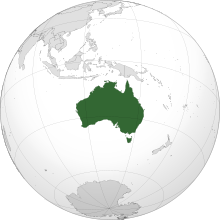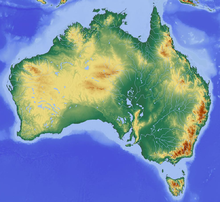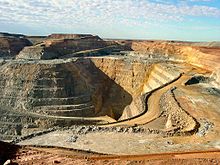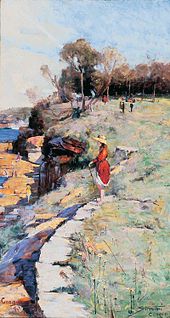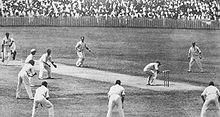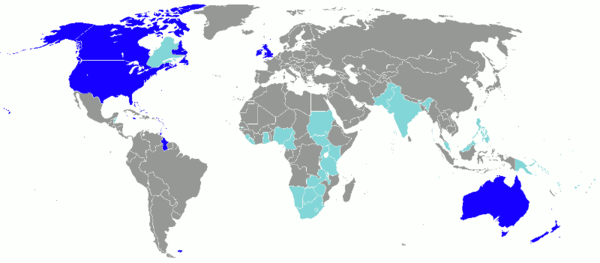- Australia
-
This article is about the country. For other uses, see Australia (disambiguation).
Commonwealth of Australia 

Flag Coat of arms Anthem: "Advance Australia Fair"[N 1]
Royal anthem: "God Save the Queen"Capital Canberra Largest city Sydney Official language(s) None[N 2] National language English (de facto)[N 2] Demonym Australian, Aussie[3][4] Government Federal parliamentary democracy and constitutional monarchy - Monarch Elizabeth II - Governor-General Quentin Bryce - Prime Minister Julia Gillard Legislature Parliament - Upper House Senate - Lower House House of Representatives Independence from the United Kingdom - Constitution 1 January 1901 - Statute of Westminster 11 December 1931 - Statute of Westminster Adoption Act 9 October 1942 (with effect from 3 September 1939) - Australia Act 3 March 1986 Area - Total 7,617,930 km2 (6th)
2,941,299 sq miPopulation - 2011 estimate 22,756,682[5] (50th) - 2006 census 19,855,288[6] - Density 2.8/km2 (233rd)
7.3/sq miGDP (PPP) 2011 estimate - Total $918.978 billion[7] (18th) - Per capita $40,836[7] (12th) GDP (nominal) 2011 estimate - Total $1.507 trillion[7] (13th) - Per capita $66,983[7] (5th) Gini (2006) 30.5[8] (medium) HDI (2011)  0.929[9] (very high) (2nd)
0.929[9] (very high) (2nd)Currency Australian dollar ( AUD)Time zone various[N 3] (UTC+8 to +10.5) - Summer (DST) various[N 3] (UTC+8 to +11.5) Drives on the left ISO 3166 code AU Internet TLD .au Calling code +61 Australia (
 /əˈstreɪljə/), officially the Commonwealth of Australia,[10] is a country in the Southern Hemisphere comprising the mainland of the Australian continent, the island of Tasmania, and numerous smaller islands in the Indian and Pacific Oceans.[N 4] It is the world's sixth-largest country by total area. Neighbouring countries include Indonesia, East Timor, and Papua New Guinea to the north; the Solomon Islands, Vanuatu, and New Caledonia to the north-east; and New Zealand to the south-east.
/əˈstreɪljə/), officially the Commonwealth of Australia,[10] is a country in the Southern Hemisphere comprising the mainland of the Australian continent, the island of Tasmania, and numerous smaller islands in the Indian and Pacific Oceans.[N 4] It is the world's sixth-largest country by total area. Neighbouring countries include Indonesia, East Timor, and Papua New Guinea to the north; the Solomon Islands, Vanuatu, and New Caledonia to the north-east; and New Zealand to the south-east.For at least 40,000 years[12] before European settlement in the late 18th century, Australia was inhabited by indigenous Australians,[13] who belonged to one or more of roughly 250 language groups.[14][15] After discovery by Dutch explorers in 1606, Australia's eastern half was claimed by Great Britain in 1770 and settled through penal transportation to the colony of New South Wales from 26 January 1788. The population grew steadily in subsequent decades; the continent was explored and an additional five self-governing Crown Colonies were established.
On 1 January 1901, the six colonies federated, forming the Commonwealth of Australia. Since Federation, Australia has maintained a stable liberal democratic political system which functions as a federal parliamentary democracy and constitutional monarchy. The federation comprises six states and several territories. The population of 22.7 million is heavily concentrated in the Eastern states and is highly urbanised.
A highly developed country, Australia is the world's thirteenth largest economy and has the world's sixth-highest per capita income. Australia's military expenditure is the world's twelfth largest. With the second-highest human development index globally, Australia ranks highly in many international comparisons of national performance, such as quality of life, health, education, economic freedom, and the protection of civil liberties and political rights.[16] Australia is a member of the G20, OECD, WTO, APEC, UN, Commonwealth of Nations, ANZUS, and the Pacific Islands Forum.
Contents
Etymology
Pronounced [əˈstɹæɪljə, -liə] in Australian English,[17] the name Australia is derived from the Latin australis, meaning "southern". The country has been referred to colloquially as Oz since the early 20th century.[N 5] Aussie is a common colloquial term for "Australian".
Legends of Terra Australis Incognita—an "unknown land of the South"—date back to Roman times and were commonplace in medieval geography, although not based on any documented knowledge of the continent. Following European discovery, names for the Australian landmass were often references to the famed Terra Australis.
The earliest recorded use of the word Australia in English was in 1625 in "A note of Australia del Espíritu Santo, written by Master Hakluyt", published by Samuel Purchas in Hakluytus Posthumus, a corruption of the original Spanish name Austrialia del Espíritu Santo for an island in Vanuatu.[22] The Dutch adjectival form Australische was used in a Dutch book in Batavia (Jakarta) in 1638, to refer to the newly discovered lands to the south.[23] Australia was later used in a 1693 translation of Les Aventures de Jacques Sadeur dans la Découverte et le Voyage de la Terre Australe, a 1676 French novel by Gabriel de Foigny, under the pen-name Jacques Sadeur.[24] Referring to the entire South Pacific region, Alexander Dalrymple used it in An Historical Collection of Voyages and Discoveries in the South Pacific Ocean in 1771. By the end of the 18th century, the name was being used to refer specifically to Australia, with the botanists George Shaw and Sir James Smith writing of "the vast island, or rather continent, of Australia, Australasia or New Holland" in their 1793 Zoology and Botany of New Holland,[25] and James Wilson including it on a 1799 chart.[26]
The name Australia was popularised by the explorer Matthew Flinders, who pushed for it to be formally adopted as early as 1804. When preparing his manuscript and charts for his 1814 A Voyage to Terra Australis, he was persuaded by his patron, Sir Joseph Banks, to use the term Terra Australis as this was the name most familiar to the public. Flinders did so, but allowed himself the footnote:
"Had I permitted myself any innovation on the original term, it would have been to convert it to Australia; as being more agreeable to the ear, and an assimilation to the names of the other great portions of the earth."[27]This is the only occurrence of the word Australia in that text; but in Appendix III, Robert Brown's General remarks, geographical and systematical, on the botany of Terra Australis, Brown makes use of the adjectival form Australian throughout,[28]—the first known use of that form.[29] Despite popular conception, the book was not instrumental in the adoption of the name: the name came gradually to be accepted over the following ten years.[30] Lachlan Macquarie, a Governor of New South Wales, subsequently used the word in his dispatches to England, and on 12 December 1817 recommended to the Colonial Office that it be formally adopted.[31] In 1824, the Admiralty agreed that the continent should be known officially as Australia.[32]
History
Main article: History of Australia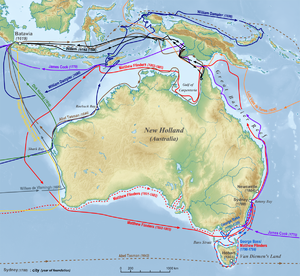 Exploration by Europeans till 1812
Exploration by Europeans till 1812
1606 Willem Janszoon1606 Luis Váez de Torres1616 Dirk Hartog1619 Frederick de Houtman1644 Abel Tasman1696 Willem de Vlamingh1699 William Dampier1770 James Cook1797–1799 George Bass1801–1803 Matthew FlindersHuman habitation of the Australian continent is estimated to have begun between 42,000 and 48,000 years ago,[33] possibly with the migration of people by land bridges and short sea-crossings from what is now South-East Asia. These first inhabitants may have been ancestors of modern Indigenous Australians. At the time of European settlement in the late 18th century, most Indigenous Australians were hunter-gatherers, with a complex oral culture and spiritual values based on reverence for the land and a belief in the Dreamtime. The Torres Strait Islanders, ethnically Melanesian, were originally horticulturalists and hunter-gatherers.[34]
Following sporadic visits by fishermen from the Malay Archipelago,[35] the first recorded European sighting of the Australian mainland and the first recorded European landfall on the Australian continent were attributed to the Dutch navigator Willem Janszoon. He sighted the coast of Cape York Peninsula on an unknown date in early 1606, and made landfall on 26 February at the Pennefather River on the western shore of Cape York, near the modern town of Weipa.[36] The Dutch charted the whole of the western and northern coastlines of "New Holland" during the 17th century, but made no attempt at settlement.[36] William Dampier, an English explorer and privateer landed on the north-west coast of Australia in 1688 and again in 1699 on a return trip. In 1770, James Cook sailed along and mapped the east coast of Australia, which he named New South Wales and claimed for Great Britain.[37] Cook's discoveries prepared the way for establishment of a new penal colony. The British Crown Colony of New South Wales was formed on 26 January 1788, when Captain Arthur Phillip led the First Fleet to Port Jackson.[38] This date became Australia's national day, Australia Day. Van Diemen's Land, now known as Tasmania, was settled in 1803 and became a separate colony in 1825.[39] The United Kingdom formally claimed the western part of Australia in 1828.[40]
Separate colonies were carved from parts of New South Wales: South Australia in 1836, Victoria in 1851, and Queensland in 1859.[41] The Northern Territory was founded in 1911 when it was excised from South Australia.[42] South Australia was founded as a "free province"—it was never a penal colony.[43] Victoria and Western Australia were also founded "free", but later accepted transported convicts.[44][45] A campaign by the settlers of New South Wales led to the end of convict transportation to that colony; the last convict ship arrived in 1848.[46]
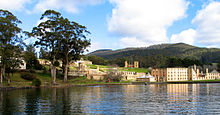 Port Arthur, Tasmania was Australia's largest gaol for transported convicts.
Port Arthur, Tasmania was Australia's largest gaol for transported convicts.
The indigenous population, estimated at 750,000 to 1,000,000 at the time of European settlement,[47] declined steeply for 150 years following settlement, mainly due to infectious disease.[48] The "Stolen Generations" (removal of Aboriginal children from their families), which historians such as Henry Reynolds have argued could be considered genocide,[49] may have contributed to the decline in the Indigenous population.[50] Such interpretations of Aboriginal history are disputed by conservative commentators such as former Prime Minister John Howard as exaggerated or fabricated for political or ideological reasons.[51] This debate is known within Australia as the History wars.[52] The Federal government gained the power to make laws with respect to Aborigines following the 1967 referendum.[53] Traditional ownership of land—aboriginal title—was not recognised until 1992, when the High Court case Mabo v Queensland (No 2) overturned the notion of Australia as terra nullius ("land belonging to no one") before European occupation.[54]
A gold rush began in Australia in the early 1850s,[55] and the Eureka Rebellion against mining licence fees in 1854 was an early expression of civil disobedience.[56] Between 1855 and 1890, the six colonies individually gained responsible government, managing most of their own affairs while remaining part of the British Empire.[57] The Colonial Office in London retained control of some matters, notably foreign affairs,[58] defence,[59] and international shipping.
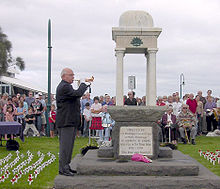 The Last Post is played at an ANZAC Day ceremony in Port Melbourne, Victoria. Similar ceremonies are held in most suburbs and towns.
The Last Post is played at an ANZAC Day ceremony in Port Melbourne, Victoria. Similar ceremonies are held in most suburbs and towns.
On 1 January 1901 federation of the colonies was achieved after a decade of planning, consultation, and voting.[60] The Commonwealth of Australia was established and it became a dominion of the British Empire in 1907. The Federal Capital Territory (later renamed the Australian Capital Territory) was formed in 1911 as the location for the future federal capital of Canberra. Melbourne was the temporary seat of government from 1901 to 1927 while Canberra was constructed.[61] The Northern Territory was transferred from the control of the South Australian government to the federal parliament in 1911.[62] In 1914, Australia joined Britain in fighting World War I, with support from both the outgoing Liberal Party and the incoming Labor Party.[63] Australians took part in many of the major battles fought on the Western Front.[64] Of about 416,000 who served, about 60,000 were killed and another 152,000 were wounded.[65] Many Australians regard the defeat of the Australian and New Zealand Army Corps (ANZACs) at Gallipoli as the birth of the nation—its first major military action.[66][67] The Kokoda Track campaign is regarded by many as an analogous nation-defining event during World War II.[68]
Britain's Statute of Westminster 1931 formally ended most of the constitutional links between Australia and the UK. Australia adopted it in 1942,[69] but it was backdated to 1939 to confirm the validity of legislation passed by the Australian Parliament during World War II.[70][71] The shock of the UK's defeat in Asia in 1942 and the threat of Japanese invasion caused Australia to turn to the United States as a new ally and protector.[72] Since 1951, Australia has been a formal military ally of the US, under the ANZUS treaty.[73] After World War II Australia encouraged immigration from Europe. Since the 1970s and following the abolition of the White Australia policy, immigration from Asia and elsewhere was also promoted.[74] As a result, Australia's demography, culture, and self-image were transformed.[75] The final constitutional ties between Australia and the UK were severed with the passing of the Australia Act 1986, ending any British role in the government of the Australian States, and closing the option of judicial appeals to the Privy Council in London.[76] In a 1999 referendum, 55 per cent of Australian voters and a majority in every Australian state rejected a proposal to become a republic with a president appointed by a two-thirds vote in both Houses of the Australian Parliament. Since the election of the Whitlam Government in 1972,[77] there has been an increasing focus in foreign policy on ties with other Pacific Rim nations, while maintaining close ties with Australia's traditional allies and trading partners.[78]
Governance
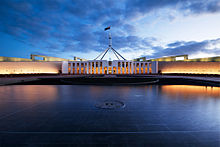 Parliament House, Canberra was opened in 1988, replacing the provisional Parliament House building opened in 1927.
Parliament House, Canberra was opened in 1988, replacing the provisional Parliament House building opened in 1927.
Australia is a constitutional monarchy with a federal division of powers. It uses a parliamentary system of government with Queen Elizabeth II at its apex as the Queen of Australia, a role that is distinct from her position as monarch of the other Commonwealth realms. The Queen resides in the United Kingdom, and she is represented by her viceroys in Australia, (the Governor-General at the federal level and by the Governors at the state level), who by convention act on the advice of her ministers. Supereme executive authority is vested by the constitution of Australia in the sovereign, but the power to exercise it is conferred by the constitution specifically to the Governor-General.[79][80] The most notable exercise of the Governor-General's reserve powers outside a Prime Minister's request was the dismissal of the Whitlam Government in the constitutional crisis of 1975.[81]
The federal government is separated into three branches:
- The legislature: the bicameral Parliament, defined in section 1 of the constitution as comprising the Queen (represented by the Governor-General), the Senate, and the House of Representatives;
- The executive: the Federal Executive Council, in practice the Governor-General as advised by the Prime Minister and Ministers of State;[82]
- The judiciary: the High Court of Australia and other federal courts, whose judges are appointed by the Governor-General on advice of the Council.
In the Senate (the upper house), there are 76 senators: twelve each from the states and two each from the mainland territories (the Australian Capital Territory and the Northern Territory).[83] The House of Representatives (the lower house) has 150 members elected from single-member electoral divisions, commonly known as "electorates" or "seats", allocated to states on the basis of population,[84] with each original state guaranteed a minimum of five seats.[85] Elections for both chambers are normally held every three years, simultaneously; senators have overlapping six-year terms except for those from the territories, whose terms are not fixed but are tied to the electoral cycle for the lower house; thus only 40 of the 76 places in the Senate are put to each election unless the cycle is interrupted by a double dissolution.[83]
Australia's electoral system uses preferential voting for all lower house elections with the exception of Tasmania and the ACT, which, along with the Senate and most state upper houses, combine it with proportional representation in a system known as the single transferable vote. Voting is compulsory for all enrolled citizens 18 years and over in every jurisdiction,[86] as is enrolment (with the exception of South Australia).[87] Although the Prime Minister is appointed by the Governor-General, in practice the party with majority support in the House of Representatives forms government and its leader becomes Prime Minister.[citation needed]
There are two major political groups that usually form government, federally and in the states: the Australian Labor Party, and the Coalition which is a formal grouping of the Liberal Party and its minor partner, the National Party.[88][89] Independent members and several minor parties—including the Greens and the Australian Democrats—have achieved representation in Australian parliaments, mostly in upper houses.
Following a partyroom leadership challenge, Julia Gillard became the first female Prime Minister in June 2010.[90] The last federal election was held on 21 August 2010 and resulted in the first hung parliament in over 50 years. Gillard was able to form a minority Labor government with the support of independents.
States and territories
Main article: States and territories of Australia A clickable map of Australia's states and mainland territories
A clickable map of Australia's states and mainland territories
Australia has six states—New South Wales, Queensland, South Australia, Tasmania, Victoria, and Western Australia—and two major mainland territories—the Northern Territory and the Australian Capital Territory (ACT). In most respects these two territories function as states, but the Commonwealth Parliament can override any legislation of their parliaments. By contrast, federal legislation overrides state legislation only in areas that are set out in Section 51 of the Australian Constitution; state parliaments retain all residual legislative powers, including those over schools, state police, the state judiciary, roads, public transport, and local government, since these do not fall under the provisions listed in Section 51.[91]
Each state and major mainland territory has its own parliament—unicameral in the Northern Territory, the ACT, and Queensland, and bicameral in the other states. The states are sovereign entities, although subject to certain powers of the Commonwealth as defined by the Constitution. The lower houses are known as the Legislative Assembly (the House of Assembly in South Australia and Tasmania); the upper houses are known as the Legislative Council. The head of the government in each state is the Premier, and in each territory the Chief Minister. The Queen is represented in each state by a Governor; and in the Northern Territory, the Administrator.[92] In the Commonwealth, the Queen's representative is the Governor-General.[93]
The federal parliament directly administers the following territories:[82]
- Jervis Bay Territory, a naval base and sea port for the national capital in land that was formerly part of New South Wales
- Christmas Island and Cocos (Keeling) Islands
- Ashmore and Cartier Islands
- Coral Sea Islands
- Heard Island and McDonald Islands
- Australian Antarctic Territory
Norfolk Island is also technically an external territory; however, under the Norfolk Island Act 1979 it has been granted more autonomy and is governed locally by its own legislative assembly. The Queen is represented by an Administrator, currently Owen Walsh.[94]
Foreign relations and military
Main articles: Foreign relations of Australia and Australian Defence Force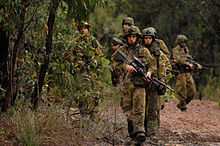 Australian Army soldiers conducting a foot patrol during a joint training exercise with US forces in Shoalwater Bay (2007).
Australian Army soldiers conducting a foot patrol during a joint training exercise with US forces in Shoalwater Bay (2007).
Over recent decades, Australia's foreign relations have been driven by a close association with the United States through the ANZUS pact, and by a desire to develop relationships with Asia and the Pacific, particularly through ASEAN and the Pacific Islands Forum. In 2005 Australia secured an inaugural seat at the East Asia Summit following its accession to the Treaty of Amity and Cooperation in Southeast Asia, and in 2011 will attend the Sixth East Asia Summit in Indonesia. Australia is a member of the Commonwealth of Nations, in which the Commonwealth Heads of Government meetings provide the main forum for cooperation.[95]
Australia has pursued the cause of international trade liberalisation.[96][97][98] It led the formation of the Cairns Group and Asia-Pacific Economic Cooperation.[99][100] Australia is a member of the Organisation for Economic Co-operation and Development and the World Trade Organization,[101][102] and has pursued several major bilateral free trade agreements, most recently the Australia – United States Free Trade Agreement[103] and Closer Economic Relations with New Zealand,[104] with another free trade agreement being negotiated with China—the Australia – China Free Trade Agreement—and Japan,[105] South Korea in 2011,[106][107] Australia–Chile Free Trade Agreement, ASEAN – Australia – New Zealand Free Trade Area, and the Trans-Pacific Strategic Economic Partnership.
Along with New Zealand, the United Kingdom, Malaysia, and Singapore, Australia is party to the Five Power Defence Arrangements, a regional defence agreement. A founding member country of the United Nations, Australia is strongly committed to multilateralism,[108] and maintains an international aid program under which some 60 countries receive assistance. The 2005–06 budget provides A$2.5 billion for development assistance;[109] as a percentage of GDP, this contribution is less than that recommended in the UN Millennium Development Goals. Australia ranks seventh overall in the Center for Global Development's 2008 Commitment to Development Index.[110]
Australia's armed forces—the Australian Defence Force (ADF)—comprise the Royal Australian Navy (RAN), the Australian Army, and the Royal Australian Air Force (RAAF), in total numbering 80,561 personnel (including 55,068 regulars and 25,493 reservists).[111] The titular role of Commander-in-Chief is vested in the Governor-General, who appoints a Chief of the Defence Force from one of the armed services on the advice of the government.[112] Day-to-day force operations are under the command of the Chief, while broader administration and the formulation of defence policy is undertaken by the Minister and Department of Defence.
In the 2010–11 budget, defence spending was A$25.7 billion,[113] representing the 14th largest defence budget in the world but accounting for only 1.2 per cent of global military spending.[114] Australia has been involved in UN and regional peacekeeping, disaster relief, and armed conflict; it currently has deployed approximately 3,330 defence force personnel in varying capacities to 12 overseas operations in areas including East Timor, Solomon Islands and Afghanistan.[115]
Geography and climate
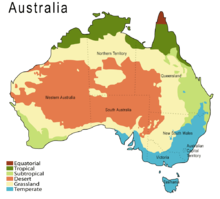 Climatic zones in Australia, based on the Köppen climate classification.
Climatic zones in Australia, based on the Köppen climate classification.
Australia's landmass of 7,617,930 square kilometres (2,941,300 sq mi)[116] is on the Indo-Australian Plate. Surrounded by the Indian[N 4] and Pacific oceans, it is separated from Asia by the Arafura and Timor seas. The world's smallest continent[117] and sixth largest country by total area,[118] Australia—owing to its size and isolation—is often dubbed the "island continent",[119] and is sometimes considered the world's largest island.[120] Australia has 34,218 kilometres (21,262 mi) of coastline (excluding all offshore islands),[121] and claims an extensive Exclusive Economic Zone of 8,148,250 square kilometres (3,146,060 sq mi). This exclusive economic zone does not include the Australian Antarctic Territory.[122] Excluding Macquarie Island, Australia lies between latitudes 9° and 44°S, and longitudes 112° and 154°E.
The Great Barrier Reef, the world's largest coral reef,[123] lies a short distance off the north-east coast and extends for over 2,000 kilometres (1,240 mi). Mount Augustus, claimed to be the world's largest monolith,[124] is located in Western Australia. At 2,228 metres (7,310 ft), Mount Kosciuszko on the Great Dividing Range is the highest mountain on the Australian mainland, although Mawson Peak on the remote Australian territory of Heard Island is taller at 2,745 metres (9,006 ft).[125]
Australia is the flattest continent,[126] with the oldest and least fertile soils;[127][128] desert or semi-arid land commonly known as the outback makes up by far the largest portion of land. The driest inhabited continent, only its south-east and south-west corners have a temperate climate.[129] The population density, 2.8 inhabitants per square kilometre, is among the lowest in the world,[130] although a large proportion of the population lives along the temperate south-eastern coastline.[131]
Eastern Australia is marked by the Great Dividing Range that runs parallel to the coast of Queensland, New South Wales, and much of Victoria—although the name is not strictly accurate, as in parts the range consists of low hills and the highlands are typically no more than 1,600 metres (5,249 ft) in height.[132] The coastal uplands and a belt of Brigalow grasslands lie between the coast and the mountains, while inland of the dividing range are large areas of grassland.[132][133] These include the western plains of New South Wales, and the Einasleigh Uplands, Barkly Tableland, and Mulga Lands of inland Queensland. The northern point of the east coast is the tropical rainforested Cape York Peninsula.[134][135][136][137]
The landscapes of the northern part of the country—the Top End and the Gulf Country behind the Gulf of Carpentaria, with their tropical climate—consist of woodland, grassland, and desert.[138][139][140] At the north-west corner of the continent are the sandstone cliffs and gorges of The Kimberley, and below that the Pilbara. South and inland of these lie more areas of grassland: the Ord Victoria Plain and the Western Australian Mulga shrublands.[141][142][143] At the heart of the country are the uplands of central Australia; prominent features of the centre and south include the inland Simpson, Tirari and Sturt Stony, Gibson, Great Sandy, Tanami, and Great Victoria deserts, with the famous Nullarbor Plain on the southern coast.[144][145][146][147]
The climate of Australia is significantly influenced by ocean currents, including the Indian Ocean Dipole and the El Niño-Southern Oscillation, which is correlated with periodic drought, and the seasonal tropical low pressure system that produces cyclones in northern Australia.[148][149] These factors induce rainfall to vary markedly from year to year. Much of the northern part of the country has a tropical predominantly summer rainfall (monsoon) climate.[150] Just under three quarters of Australia lies within a desert or semi-arid zone.[151] The southwest corner of the country has a Mediterranean climate.[152] Much of the southeast (including Tasmania) is temperate.[150]
Environment
Main article: Environment of AustraliaAlthough most of Australia is semi-arid or desert, it includes a diverse range of habitats from alpine heaths to tropical rainforests, and is recognised as a megadiverse country. Because of the continent's great age, extremely variable weather patterns, and long-term geographic isolation, much of Australia's biota is unique and diverse. About 85 per cent of flowering plants, 84 per cent of mammals, more than 45 per cent of birds, and 89 per cent of in-shore, temperate-zone fish are endemic.[153] Australia has the greatest number of reptiles of any country, with 755 species.[154]
Australian forests are mostly made up of evergreen species, particularly eucalyptus trees in the less arid regions, wattles replace them in drier regions and deserts as the most dominant species.[155] Among well-known Australian fauna are the monotremes (the platypus and echidna); a host of marsupials, including the kangaroo, koala, and wombat, and birds such as the emu and the kookaburra.[155] Australia is home to many dangerous animals including some of the most venomous snakes in the world.[156] The dingo was introduced by Austronesian people who traded with Indigenous Australians around 3000 BCE.[157] Many plant and animal species became extinct soon after first human settlement,[158] including the Australian megafauna; others have disappeared since European settlement, among them the thylacine.[159][160]
Many of Australia's ecoregions, and the species within those regions, are threatened by human activities and introduced plant and animal species.[161] The federal Environment Protection and Biodiversity Conservation Act 1999 is the legal framework for the protection of threatened species.[162] Numerous protected areas have been created under the National Strategy for the Conservation of Australia's Biological Diversity to protect and preserve unique ecosystems;[163][164] 65 wetlands are listed under the Ramsar Convention,[165] and 16 natural World Heritage Sites have been established.[166] Australia was ranked 51st of 163 countries in the world on the 2010 Environmental Performance Index.[167]
Climate change has become an increasing concern in Australia in recent years,[168] with many Australians considering protection of the environment to be the most important issue facing the country.[169] The Rudd Ministry has initiated several emission reduction activities;[170] Rudd's first official act, on his first day in office, was to sign the instrument of ratification of the Kyoto Protocol. Nevertheless, Australia's carbon dioxide emissions per capita are among the highest in the world, lower than those of only a few other industrialised nations.[171] Rainfall in Australia has slightly increased over the past century, both nationwide and for two quadrants of the nation,[172] while annual mean temperatures increased significantly over the past decades.[173] Water restrictions are frequently in place in many regions and cities of Australia in response to chronic shortages due to urban population increases and localised drought.[174][175]
Economy
Main article: Economy of AustraliaAustralia has a market economy with high GDP per capita and low rate of poverty. The Australian dollar is the currency for the nation, including Christmas Island, Cocos (Keeling) Islands, and Norfolk Island, as well as the independent Pacific Island states of Kiribati, Nauru, and Tuvalu. After the 2006 merger of the Australian Stock Exchange and the Sydney Futures Exchange, the Australian Securities Exchange is now the ninth largest in the world.[177]
Ranked third in the Index of Economic Freedom (2010),[178] Australia is the world's thirteenth largest economy and has the ninth highest per capita GDP; higher than that of the United Kingdom, Germany, France, Canada, Japan, and the United States. The country was ranked second in the United Nations 2010 Human Development Index and first in Legatum's 2008 Prosperity Index.[179] All of Australia's major cities fare well in global comparative livability surveys;[180] Melbourne reached first place on The Economist's 2011 World's Most Livable Cities list, followed by Sydney, Perth, and Adelaide in sixth, eighth, and ninth place respectively.[181] Total government debt in Australia is about $190 billion.[182] Australia has among the highest house prices and some of the highest household debt levels in the world.[183]
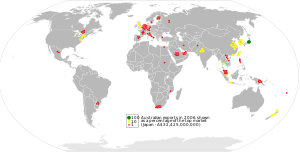 Destination and value of Australian exports in 2006[184]
Destination and value of Australian exports in 2006[184]
An emphasis on exporting commodities rather than manufactured goods has underpinned a significant increase in Australia's terms of trade since the start of the century, due to rising commodity prices. Australia has a balance of payments that is more than 7 per cent of GDP negative, and has had persistently large current account deficits for more than 50 years.[185] Australia has grown at an average annual rate of 3.6 per cent for over 15 years, in comparison to the OECD annual average of 2.5 per cent.[185] There are differing opinions based on evidence as to whether or not Australia had been one of the few OECD nations to avoid experiencing a recession during the late 2000s global financial downturn.[186][186][187] Six of Australia's major trading partners had been in recession which in turn affected Australia, and economic growth was hampered significantly over recent years.[188][189]
The Hawke Government floated the Australian dollar in 1983 and partially deregulated the financial system.[190] The Howard Government followed with a partial deregulation of the labour market and the further privatisation of state-owned businesses, most notably in the telecommunications industry.[191] The indirect tax system was substantially changed in July 2000 with the introduction of a 10 per cent Goods and Services Tax (GST).[192] In Australia's tax system, personal and company income tax are the main sources of government revenue.[193]
In July 2011, there were 11,450,500 people employed, with an unemployment rate of 5.1 per cent.[194] Youth unemployment (15–24) rose from 8.7 per cent to 9.7 per cent over 2008–2009.[195] Over the past decade, inflation has typically been 2–3 per cent and the base interest rate 5–6 per cent. The service sector of the economy, including tourism, education, and financial services, accounts for about 70 per cent of GDP.[196] Rich in natural resources, Australia is a major exporter of agricultural products, particularly wheat and wool, minerals such as iron-ore and gold, and energy in the forms of liquified natural gas and coal. Although agriculture and natural resources account for only 3 per cent and 5 per cent of GDP respectively, they contribute substantially to export performance. Australia's largest export markets are Japan, China, the US, South Korea, and New Zealand.[197] Australia is the world's fourth largest exporter of wine, in an industry contributing $5.5 billion per annum to the nation's economy.[198]
Demography
Main articles: Demographics of Australia and Immigration to AustraliaHistoric population (Estimated) [199] Year Indigenous population pre 1788 750,000 to 1,000,000 [47] Year Non Indigenous population Annual increase % 1788 900 — 1800 5,200 14.6% 1850 405,400 8.7% Year Total population Annual increase % 1900 3,765,300 — 1910 4,525,100 1.8% 1920 5,411,000 1.8% 1930 6,501,000 1.8% 1940 7,078,000 0.9% 1950 8,307,000 1.6% 1960 10,392,000 2.2% 1970 12,663,000 2.0% 1980 14,726,000 1.5% 1990 17,169,000 1.5% 2000 19,169,100 1.1% 2010 20,971,000 0.9% For generations, the vast majority of immigrants came from the British Isles, and the people of Australia are still mainly of British or Irish ethnic origin. In the 2006 Australian census, the most commonly nominated ancestry was Australian (37.13 per cent),[200] followed by English (32 per cent), Irish (9 per cent), Scottish (8 per cent), Italian (4 per cent), German (4 per cent), Chinese (3 per cent), and Greek (2 per cent).[201]
Australia's population has quadrupled since the end of World War I,[202] much of the increase from immigration. Following World War II and through to 2000, almost 5.9 million of the total population settled in the country as new immigrants, meaning that nearly two out of every seven Australians were born overseas.[203] Most immigrants are skilled,[204] but the immigration quota includes categories for family members and refugees.[204] By 2050, Australia's population is currently projected to reach around 42 million.[205]
In 2001, 23.1 per cent of Australians were born overseas; the five largest immigrant groups were those from the United Kingdom, New Zealand, Italy, Vietnam, and China.[197][206] Following the abolition of the White Australia policy in 1973, numerous government initiatives have been established to encourage and promote racial harmony based on a policy of multiculturalism.[207] In 2005–06, more than 131,000 people emigrated to Australia, mainly from Asia and Oceania.[208] The migration target for 2010–11 is 168,700, compared to 67,900 in 1998–99.[209]
The Indigenous population—mainland Aborigines and Torres Strait Islanders—was counted at 410,003 (2.2 per cent of the total population) in 2001, a significant increase from 115,953 in the 1976 census.[210] A large number of Indigenous people are not identified in the Census due to undercount and cases where their Indigenous status is not recorded on the form; after adjusting for these factors, the ABS estimated the true figure for 2001 to be around 460,140 (2.4 per cent of the total population).[211]
Indigenous Australians experience higher than average rates of imprisonment and unemployment,[212] lower levels of education, and life expectancies for males and females that are 11–17 years lower than those of non-indigenous Australians.[197][213][214] Some remote Indigenous communities have been described as having "failed state"-like conditions.[215][216][217][218][219]
In common with many other developed countries, Australia is experiencing a demographic shift towards an older population, with more retirees and fewer people of working age. In 2004, the average age of the civilian population was 38.8 years.[220] A large number of Australians (759,849 for the period 2002–03)[221] live outside their home country.
Largest populated areas in Australia
(June 2010 Australian Bureau of Statistics estimate)[222]Rank City Name State Pop. Rank City Name State Pop. 1 Sydney NSW 4,575,532 11 Greater Hobart TAS 214,705 2 Melbourne VIC 4,077,036 12 Geelong VIC 178,650 3 Brisbane QLD 2,043,185 13 Townsville QLD 172,316 4 Perth WA 1,696,065 14 Cairns QLD 150,920 5 Adelaide SA 1,203,186 15 Toowoomba QLD 131,258 6 Gold Coast-Tweed QLD / NSW 591,473 16 Darwin NT 127,532 7 Newcastle NSW 546,788 17 Launceston TAS 106,153 8 Canberra-Queanbeyan ACT / NSW 410,419 18 Albury-Wodonga NSW / VIC 106,052 9 Wollongong NSW 292,190 19 Ballarat VIC 96,097 10 Sunshine Coast QLD 251,081 20 Bendigo VIC 91,713 Language
Main article: Australian English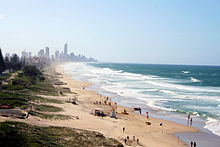 Nearly three quarters of Australians live in metropolitan cities and coastal areas. The beach is an integral part of the Australian identity.[223]
Nearly three quarters of Australians live in metropolitan cities and coastal areas. The beach is an integral part of the Australian identity.[223]
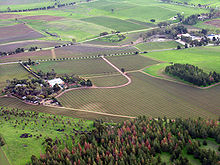 The Barossa Valley is a wine-producing region in South Australia. Fewer than 15 per cent of Australians live in rural areas.
The Barossa Valley is a wine-producing region in South Australia. Fewer than 15 per cent of Australians live in rural areas.
Although Australia has no official language, English is so entrenched that it has become the de facto national language.[2] Australian English is a major variety of the language with a distinctive accent and lexicon. Grammar and spelling are similar to that of British English with some notable exceptions.[224] According to the 2006 census, English is the only language spoken in the home for close to 79 per cent of the population. The next most common languages spoken at home are Italian (1.6 per cent), Greek (1.3 per cent) and Cantonese (1.2 per cent);[225] a considerable proportion of first- and second-generation migrants are bilingual. A 2010–2011 study by the Australia Early Development Index found that the most common language spoken by children after English was Arabic, followed by Vietnamese, Greek, Chinese, and Hindi.[226]
Between 200 and 300 Indigenous Australian languages are thought to have existed at the time of first European contact, of which only about 70 have survived. Many of these are exclusively spoken by older people; only 18 Indigenous languages are still spoken by all age groups.[227] At the time of the 2006 Census, 52,000 Indigenous Australians, representing 12 per cent of the Indigenous population, reported that they spoke an Indigenous language at home.[228] Australia has a sign language known as Auslan, which is the main language of about 5,500 deaf people.[229]
Religion
Main article: Religion in AustraliaAustralia has no state religion. In the 2006 census, 64 per cent of Australians listed themselves as Christian, including 26 per cent as Roman Catholic and 19 per cent as Anglican. About 19 per cent of the population cited "No religion" (which includes humanism, atheism, agnosticism and rationalism), which was the fastest-growing group from 2001 to 2006, and a further 12 per cent did not answer (the question is optional) or did not give a response adequate for interpretation. The largest non-Christian religion in Australia is Buddhism (2.1 per cent), followed by Islam (1.7 per cent), Hinduism (0.8 per cent) and Judaism (0.5 per cent). Overall, fewer than 6 per cent of Australians identify with non-Christian religions.[230] Weekly attendance at church services in 2004 was about 1.5 million: about 7.5 per cent of the population.[231]
An international survey, made by the private, not-for profit German think-tank, the Bertelsmann Foundation, found that "Australia is one of the least religious nations in the western world, coming in 17th out of 21 [countries] surveyed" and that "Nearly three out of four Australians say they are either not at all religious or that religion does not play a central role in their lives.".[232] A survey of 1,718 Australians by the Christian Research Association at the end of 2009 suggested that the numbers of people attending religious services per month in Australia has dropped from 23 per cent in 1993 to 16 per cent in 2009, and while 60 per cent of 15 to 29-year-old respondents in 1993 identified with Christian denominations, 33 per cent did in 2009.[233]
Education
Main article: Education in AustraliaMain article: Tertiary education fees in AustraliaSchool attendance is compulsory throughout Australia. All children receive 11 years of compulsory education from the age of 6 to 16 (Year 1 to 10),[234] before they can undertake two more years (Years 11 and 12), contributing to an adult literacy rate that is assumed to be 99 per cent. A preparatory year prior to Year 1, although not compulsory, is almost universally undertaken.[234] In the Programme for International Student Assessment, Australia regularly scores among the top five of thirty major developed countries (member countries of the Organisation for Economic Co-operation and Development). Government grants have supported the establishment of Australia's 38 universities; all but one is public.[citation needed] OECD places Australia as among the most expensive nations to attend university.[235] There is a state-based system of vocational training, known as TAFE Institutes, and many trades conduct apprenticeships for training new tradespeople.[236] Approximately 58 per cent of Australians aged from 25 to 64 have vocational or tertiary qualifications,[197] and the tertiary graduation rate of 49 per cent is the highest among OECD countries. The ratio of international to local students in tertiary education in Australia is the highest in the OECD countries.[237]
Health
Life expectancy in Australia in 2006 was 78.7 years for males and 83.5 years for females.[238] Australia has the highest rates of skin cancer in the world,[239] while cigarette smoking is the largest preventable cause of death and disease.[240] Australia has one of the highest proportions of overweight citizens among developed nations.[241]
Main article: Health care in AustraliaTotal expenditure on health (including private sector spending) is around 9.8 per cent of GDP.[242] Australia introduced universal health care in 1975.[243] Known as Medicare it is now nominally funded by an income tax surcharge known as the Medicare levy, currently set at 1.5 per cent.[244] The states manage hospitals and attached outpatient services, while the Commonwealth funds the Pharmaceutical Benefits Scheme (reducing the costs of medicines) and general practice.[243]
Culture
Main article: Culture of Australia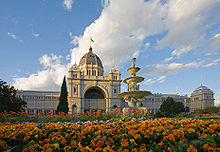 The Royal Exhibition Building in Melbourne was the first building in Australia to be listed as a UNESCO World Heritage Site in 2004[245]
The Royal Exhibition Building in Melbourne was the first building in Australia to be listed as a UNESCO World Heritage Site in 2004[245]
Since 1788, the basis of Australian culture has been strongly influenced by Anglo-Celtic Western culture.[246][247] Distinctive cultural features have also arisen from Australia's natural environment and Indigenous cultures.[248][249] Since the mid-20th century, American popular culture has strongly influenced Australia, particularly through television and cinema.[250] Other cultural influences come from neighbouring Asian countries, and through large-scale immigration from non-English-speaking nations.[250][251]
Arts
Main article: Visual arts of AustraliaAustralian visual arts are thought to have begun with the cave and bark paintings of its Indigenous peoples. The traditions of Indigenous Australians are largely transmitted orally, through ceremony and the telling of Dreamtime stories.[252] From the time of European settlement, a theme in Australian art has been the natural landscape,[248] seen for example in the works of Albert Namatjira,[253] Arthur Streeton and others associated with the Heidelberg School,[248] and Arthur Boyd.[254]
The country's landscape remains a source of inspiration for Australian modernist artists; it has been depicted in acclaimed works by the likes of Sidney Nolan,[255] Fred Williams,[256] Sydney Long,[257] and Clifton Pugh.[258] Australian artists influenced by modern American and European art include cubist Grace Crowley,[259] surrealist James Gleeson,[260] and pop artist Martin Sharp.[261] Contemporary Indigenous Australian art is the only art movement of international significance to emerge from Australia[262][263] and "the last great art movement of the 20th century";[264] its exponents have included Emily Kngwarreye.[265][266] Art critic Robert Hughes has written several influential books about Australian history and art, and was described as the "world's most famous art critic" by The New York Times.[267] The National Gallery of Australia and state galleries maintain Australian and overseas collections.[268]
Main articles: Theatre of Australia and Dance in AustraliaMany of Australia's performing arts companies receive funding through the federal government's Australia Council.[269] There is a symphony orchestra in each state,[270] and a national opera company, Opera Australia,[271] well-known for its famous soprano Joan Sutherland.[272] At the start of the 20th century, Nellie Melba was one of the world's leading opera singers.[273] Ballet and dance are represented by The Australian Ballet and various state companies. Each state has a publicly funded theatre company.[274][275][276]
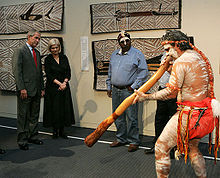 Performance of Aboriginal song and dance in the Australian National Maritime Museum in Sydney
Performance of Aboriginal song and dance in the Australian National Maritime Museum in Sydney
Australian literature has also been influenced by the landscape; the works of writers such as Banjo Paterson, Henry Lawson, and Dorothea Mackellar captured the experience of the Australian bush.[277] The character of the nation's colonial past, as represented in early literature, is popular with modern Australians.[248] In 1973, Patrick White was awarded the Nobel Prize in Literature,[278] the first Australian to have achieved this.[279] Australian winners of the Man Booker Prize have included Peter Carey and Thomas Keneally;[280] David Williamson, David Malouf, and J. M. Coetzee, who recently became an Australian citizen, are also renowned writers,[281] and Les Murray is regarded as "one of the leading poets of his generation".[282]
Media
Main articles: Television in Australia, Cinema of Australia, Media of Australia, Australian literature, and Music of AustraliaThe Australian cinema industry began with the 1906 release of The Story of the Kelly Gang, which is regarded as being the world's first feature-length film;[283] but both Australian feature film production and the distribution of British-made features declined dramatically after World War I as American studios and distributors monopolised the industry,[284] and by the 1930s around 95 per cent of the feature films screened in Australia were produced in Hollywood. By the late 1950s feature film production in Australia had effectively ceased and there were no all-Australian feature films made in the decade between 1959 and 1969.[285]
Thanks to initiatives by the Gorton and Whitlam federal governments, the New Wave of Australian cinema of the 1970s brought provocative and successful films, some exploring the nation's colonial past, such as Picnic at Hanging Rock and Breaker Morant,[286] while the so-called "Ocker" genre produced several highly successful urban-based comedy features including The Adventures of Barry McKenzie and Alvin Purple.[287][288][289] Later hits included Mad Max and Gallipoli.[290][291] More recent successes included Shine and Rabbit-Proof Fence.[292][293] Notable Australian actors include Judith Anderson,[294] Errol Flynn,[295] Nicole Kidman, Hugh Jackman, Heath Ledger, Geoffrey Rush, and Cate Blanchett—current joint director of the Sydney Theatre Company.[296][297]
Australia has two public broadcasters (the Australian Broadcasting Corporation and the multicultural Special Broadcasting Service), three commercial television networks, several pay-TV services,[298] and numerous public, non-profit television and radio stations. Each major city has at least one daily newspaper,[298] and there are two national daily newspapers, The Australian and The Australian Financial Review.[298] In 2010, Reporters Without Borders placed Australia 18th on a list of 178 countries ranked by press freedom, behind New Zealand (8th) but ahead of the United Kingdom (19th) and United States (20th).[299] This relatively low ranking is primarily because of the limited diversity of commercial media ownership in Australia;[300] most print media are under the control of News Corporation and Fairfax Media.[301]
Cuisine
Main article: Australian cuisineThe food of Indigenous Australians was largely influenced by the area in which they lived. Most tribal groups subsisted on a simple hunter-gatherer diet, hunting native game and fish and collecting native plants and fruit. The general term for native Australian flora and fauna used as a source of food is bush tucker.[302][303] The first settlers introduced British food to the continent[304] which much of what is now considered typical Australian food is based on the Sunday roast has become an enduring tradition for many Australians.[305] Since the beginning of the 20th century, food in Australia has increasingly been influenced by immigrants to the nation, particularly from Southern European and Asian cultures.[304][305] Australian wine is produced in 60 distinct production areas totaling approximately 160,000 hectares, mainly in the southern, cooler parts of the country. The wine regions in each of these states produce different wine varieties and styles that take advantage of local climates and soil types. The predominant varieties are Shiraz, Cabernet Sauvignon, Chardonnay, Merlot, Sémillon, Pinot noir, Riesling, and Sauvignon blanc.[306][307][308][198][309][310] In 1995, an Australian red wine, Penfolds Grange, won the Wine Spectator award for Wine of the Year, the first time a wine from outside France or California achieved this distinction.[311]
Sport
Main article: Sport in AustraliaAround 24 per cent Australians over the age of 15 regularly participate in organised sporting activities in Australia.[197] Australia has strong international teams in cricket, field hockey, netball, rugby league, and rugby union, having been Olympic or world champions at least twice in each sport in the last 25 years for both men and women where applicable.[313][314][315][316][317][318][319][320] Australia is also powerful in track cycling, rowing, and swimming, having consistently been in the top-five medal-winners at Olympic or World Championship level since 2000.[321][322][323] Swimming is the strongest of these sports; Australia is the second-most prolific medal winner in the sport in Olympic history.[324][325][326]
Some of Australia's most internationally well-known and successful sportspeople are swimmers Dawn Fraser, Murray Rose, Shane Gould, and Ian Thorpe; sprinters Shirley Strickland, Betty Cuthbert, and Cathy Freeman;[327] tennis players Rod Laver, Roy Emerson, Ken Rosewall, Evonne Goolagong, and Margaret Court; cricketers Donald Bradman and Shane Warne; three-time Formula One world champion Jack Brabham; five-time motorcycle grand prix world champion Mick Doohan; golfers Greg Norman and Karrie Webb;[328] cyclist Hubert Opperman; and prodigious billiards player Walter Lindrum.[329] Nationally, other popular sports include Australian rules football, horse racing, squash, surfing, soccer, and motor racing. The annual Melbourne Cup horse race and the Sydney to Hobart yacht race attract intense interest.
Australia has participated in every summer Olympics of the modern era,[330] and every Commonwealth Games.[331] Australia hosted the 1956 Summer Olympics in Melbourne and the 2000 Summer Olympics in Sydney,[332] and has ranked among the top six medal-takers since 2000.[333] Australia has also hosted the 1938, 1962, 1982, and 2006 Commonwealth Games.[334] Other major international events held in Australia include the Australian Open tennis grand slam tournament, international cricket matches, and the Australian Formula One Grand Prix. Sydney hosted the 2003 Rugby World Cup and the annual Australia–New Zealand Bledisloe Cup is keenly watched. The highest-rating television programs include sports telecasts such as the summer Olympics, FIFA World Cup, Rugby League State of Origin, and the grand finals of the National Rugby League and Australian Football League.[335] Skiing in Australia began in the 1860s and snow sports take place in the Australian Alps and parts of Tasmania.
See also
- Outline of Australia
- Index of Australia-related articles
Notes
- ^ Australia also has a royal anthem, "God Save the Queen (or King)", which is played in the presence of a member of the Royal family when they are in Australia. In all other appropriate contexts, the national anthem of Australia, "Advance Australia Fair", is played.[1]
- ^ a b English does not have de jure status.[2]
- ^ a b There are minor variations from these three time zones, see Time in Australia.
- ^ a b Australia describes the body of water south of its mainland as the Southern Ocean, rather than the Indian Ocean as defined by the International Hydrographic Organization (IHO). In 2000, a vote of IHO member nations defined the term "Southern Ocean" as applying only to the waters between Antarctica and 60 degrees south latitude.[11]
- ^ The Oxford English Dictionary records a first occurrence in 1908, in the form Oss. Oz is often taken as an oblique reference to the fictional Land of Oz in the film The Wizard of Oz (1939), based on L. Frank Baum's novel The Wonderful Wizard of Oz (1900).[18] Australians' "image of Australia as a 'Land of Oz' is not new, and dedication to it runs deep".[19] The spelling Oz is likely to have been influenced by the 1939 film, though the pronunciation was probably always with a /z/, as it is also for Aussie, sometimes spelt Ozzie.[20] The Baz Luhrmann film Australia (2008) makes repeated reference to The Wizard of Oz, which appeared just before the wartime action of Australia. Some critics have even speculated that Baum was inspired by Australia, in naming the Land of Oz: "In Ozma of Oz (1907) Dorothy gets back to Oz as the result of a storm at sea while she and Uncle Henry are traveling by ship to Australia. So, like Australia, Oz is somewhere to the west of California. Like Australia, Oz is an island continent. Like Australia, Oz has inhabited regions bordering on a great desert. One might almost imagine that Baum intended Oz to be Australia, or perhaps a magical land in the center of the great Australian desert."[21]
References
- ^ It's an Honour – Symbols – Australian National Anthem and DFAT – "The Australian National Anthem"; "National Symbols". Parliamentary Handbook of the Commonwealth of Australia (29th ed.). 2002 (updated 2005). http://web.archive.org/web/20070611101901/http://www.aph.gov.au/library/handbook/40thparl/national+symbols.pdf. Retrieved 7 June 2007.
- ^ a b "Pluralist Nations: Pluralist Language Policies?". 1995 Global Cultural Diversity Conference Proceedings, Sydney. Department of Immigration and Citizenship. http://www.immi.gov.au/media/publications/multicultural/confer/04/speech18b.htm. Retrieved 11 January 2009. "English has no de jure status but it is so entrenched as the common language that it is de facto the official language as well as the national language."
- ^ The Macquarie Dictionary
- ^ Collins English Dictionary. Bishopbriggs, Glasgow: HarperCollins. 2009. p. 18. ISBN 978-0-00-786171-2.
- ^ "Population clock". Australian Bureau of Statistics website. Commonwealth of Australia. http://www.abs.gov.au/ausstats/abs@.nsf/94713ad445ff1425ca25682000192af2/1647509ef7e25faaca2568a900154b63?OpenDocument. Retrieved 25 July 2011. The population estimate shown is automatically calculated daily at 00:00 UTC and is based on data obtained from the population clock on the date shown in the citation.
- ^ Australian Bureau of Statistics (25 October 2007). "Australia". 2006 Census QuickStats. http://www.censusdata.abs.gov.au/ABSNavigation/prenav/LocationSearch?collection=Census&period=2006&areacode=0&producttype=QuickStats&breadcrumb=PL&action=401. Retrieved 14 October 2008.
- ^ a b c d "Australia". IMF website. Washington, D.C.: International Monetary Fund.
- ^ "Distribution of family income – Gini index". The World Factbook. CIA. https://www.cia.gov/library/publications/the-world-factbook/fields/2172.html. Retrieved 2009-09-01.
- ^ "Human Development Report 2011". United Nations. http://hdr.undp.org/en/media/HDR_2011_EN_Table1.pdf. Retrieved 2011-11-02.
- ^ "Constitution of Australia". ComLaw. 1 June 2003. http://www.comlaw.gov.au/Details/C2005Q00193/0332ed71-e2d9-4451-b6d1-33ec4b570e9f. Retrieved 5 August 2011. "3. It shall be lawful for the Queen, with the advice of the Privy Council, to declare by proclamation that, on and after a day therein appointed, not being later than one year after the passing of this Act, the people of New South Wales, Victoria, South Australia, Queensland, and Tasmania, and also, if Her Majesty is satisfied that the people of Western Australia have agreed thereto, of Western Australia, shall be united in a Federal Commonwealth under the name of the Commonwealth of Australia."
- ^ Rosenberg, Matt (20 August 2009). "The New Fifth Ocean–The World's Newest Ocean – The Southern Ocean". About.com: Geography. http://geography.about.com/od/learnabouttheearth/a/fifthocean.htm. Retrieved 5 April 2010.
- ^ http://www.nytimes.com/2011/09/23/science/23aborigines.html
- ^ Both Australian Aborigines and Europeans Rooted in Africa – 50,000 years ago.
- ^ "Australian Social Trends". Australian Bureau of Statistics website. Commonwealth of Australia. http://www.abs.gov.au/ausstats/abs@.NSF/2f762f95845417aeca25706c00834efa/aadb12e0bbec2820ca2570ec001117a5!OpenDocument. Retrieved 6 June 2008.
- ^ Michael Walsh. 'Overview of indigenous languages of Australia' in Suzane Romaine (ed) Language in Australia (Cambridge: Cambridge University Press, 1991) ISBN 0-521-33983-9
- ^ "Australia: World Audit Democracy Profile". WorldAudit.org. http://www.worldaudit.org/countries/australia.htm. Retrieved 5 January 2008.
- ^ Australian pronunciations: Macquarie Dictionary, Fourth Edition (2005). Melbourne, The Macquarie Library Pty Ltd. ISBN 1-876429-14-3
- ^ Jacobson, H., In the Land of Oz, Penguin, 1988, ISBN 0-14-010966-8.
- ^ The Americana Annual: 1988, Americana Corporation, vol. 13, 1989, p. 66, ISBN 0-7172-0220-8.
- ^ Partridge, Eric, et al., The New Partridge Dictionary of Slang and Unconventional English, Taylor & Francis, 2006, ISBN 0-415-25938-X, entries "Oz" and "Ozzie", p. 1431.
- ^ Algeo, J., "Australia as the Land of Oz", American Speech, Vol. 65, No. 1, 1990, pp. 86–89.
- ^ Purchas, vol. iv, pp. 1422–32, 1625. This appears to be variation of the original Spanish "Austrialia" [sic].[1] A copy at the Library of Congress can be read online [2].
- ^ Scott, Ernest (2004) [1914]. The Life of Captain Matthew Flinders. Kessinger Publishing. p. 299. ISBN 978-1-4191-6948-9. http://books.google.com/?id=DDNEle_1NzkC&pg=PA299&dq=Australische+1638+batavia#v=onepage&q=Australische%201638%20batavia&f=false.
- ^ Sidney J. Baker, The Australian Language, second edition, 1966.
- ^ Ferguson, John Alexander (1975). Bibliography of Australia: 1784–1830. 1 (reprint ed.). National Library of Australia. p. 77. ISBN 0-642-99044-1. http://books.google.com/?id=KQzgC-xeQkIC.
- ^ Estensen, Miriam (2002). The Life of Matthew Flinders. Allen & Unwin. p. 354. ISBN 1-74114-152-4.
- ^ Flinders, Matthew (1814). A Voyage to Terra Australis. G. and W. Nicol.
- ^ Bennett, J. J., ed (1866–68). "General remarks, geographical and systematical, on the botany of Terra Australis". The Miscellaneous Botanical Works of Robert Brown, Esq., D.C.L., F.R.S.. 2. pp. 1–89.
- ^ Mabberley, David (1985). Jupiter botanicus: Robert Brown of the British Museum. British Museum (Natural History). ISBN 3-7682-1408-7.
- ^ Estensen, p. 450
- ^ Weekend Australian, 30–31 December 2000, p. 16
- ^ Department of Immigration and Citizenship (2007). Life in Australia. Commonwealth of Australia. p. 11. ISBN 978-1-921446-30-6. http://www.immi.gov.au/living-in-australia/values/book/english/lia_english_part1.pdf. Retrieved 30 March 2010.
- ^ Gillespie, Richard (2002). "Dating the First Australians (full text)" (PDF). Radiocarbon 44 (2): 455–472. http://www-personal.une.edu.au/~pbrown3/Gillespie02.pdf. Retrieved 2010-12-07.
- ^ Viegas, Jennifer (3 July 2008). "Early Aussie Tattoos Match Rock Art". Discovery News. http://dsc.discovery.com/news/2008/07/03/australia-tattoos-art.html. Retrieved 30 March 2010.
- ^ MacKnight, CC (1976). The Voyage to Marege: Macassan Trepangers in Northern Australia. Melbourne University Press.
- ^ a b Davison, Hirst and Macintyre, p. 233.
- ^ "European discovery and the colonisation of Australia". Australian Government: Culture Portal. Department of the Environment, Water, Heritage and the Arts, Commonwealth of Australia. 11 January 2008. http://www.cultureandrecreation.gov.au/articles/australianhistory/. Retrieved 7 May 2010.
- ^ Davison, Hirst and Macintyre, pp. 157, 254.
- ^ Davison, Hirst and Macintyre, pp. 464–65, 628–29.
- ^ Davison, Hirst and Macintyre, p. 678.
- ^ Davison, Hirst and Macintyre, p. 464.
- ^ Davison, Hirst and Macintyre, p. 470.
- ^ Davison, Hirst and Macintyre, p. 598.
- ^ Davison, Hirst and Macintyre, p. 679.
- ^ Convict Records Public Record office of Victoria; State Records Office of Western Australia[dead link].
- ^ "1998 Special Article – The State of New South Wales – Timeline of History". Australian Bureau of Statistics. 1988. http://www.abs.gov.au/Ausstats/abs%40.nsf/0/A890E87A9AB97424CA2569DE0025C18B?Open.
- ^ a b Briscoe, Gordon; Smith, Len (2002). The Aboriginal Population Revisited: 70,000 years to the present. Canberra, Australia: Aboriginal History Inc.. p. 12. ISBN 9780958563765.
- ^ "Smallpox Through History". Smallpox Through History. http://encarta.msn.com/media_701508643/Smallpox_Through_History.html.
- ^ Tatz, Colin (1999). "Genocide in Australia". AIATSIS Research Discussion Papers No 8. Australian Institute of Aboriginal and Torres Strait Islander Studies. Archived from the original on 8 August 2005. http://web.archive.org/web/20050808002313/http://www.aiatsis.gov.au/rsrch/rsrch_dp/genocide.htm. Retrieved 13 September 2007.
- ^ Attwood, Bain (2005). Telling the truth about Aboriginal history. Crows Nest, New South Wales: Allen & Unwin. ISBN 1-74114-577-5. http://www.questia.com/read/109251500?title=Telling%20the%20Truth%20about%20Aboriginal%20History.
- ^ Davison, Hirst and Macintyre, pp. 72–73.
- ^ Mark, David (27 August 2009). "Rudd calls for end to 'history wars'". Australian Broadcasting Corporation. http://www.abc.net.au/news/stories/2009/08/27/2669177.htm. Retrieved 23 April 2010.
- ^ Dawkins, Kezia (1 February 2004). "1967 Referendum". Australian Broadcasting Corporation. http://www.abc.net.au/messageclub/duknow/stories/s888141.htm. Retrieved 30 March 2010.
- ^ Davison, Hirst and Macintyre, pp. 5–7, 402.
- ^ Davison, Hirst and Macintyre, pp. 283–85.
- ^ Davison, Hirst and Macintyre, pp.227–29.
- ^ Davison, Hirst and Macintyre, p. 556.
- ^ Davison, Hirst and Macintyre, pp. 138–39.
- ^ "Colonial Defence and Imperial Repudiation". Daily Southern Cross (vol XVII, issue 1349). 13 November 1860. http://paperspast.natlib.govt.nz/cgi-bin/paperspast?a=d&d=DSC18601113.2.12&l=mi&e=-------10--1----0-all. Retrieved 4 April 2010.
- ^ Davison, Hirst and Macintyre, pp. 243–44.
- ^ Otto, Kristin (25 June – 9 July 2007). "When Melbourne was Australia’s capital city". Melbourne, Victoria: University of Melbourne. http://uninews.unimelb.edu.au/news/4332/. Retrieved 29 March 2010.
- ^ Official year book of the Commonwealth of Australia. Australian Bureau of Statistics. 1957. http://books.google.com/?id=-embDa-x6MwC. Retrieved 29 March 2010.
- ^ Stuart Macintyre, The Oxford History of Australia: vol 4 (1986), p. 142; C. Bean Ed. (1941). Volume I – The Story of Anzac: the first phase, First World War Official Histories, Eleventh Edition.
- ^ "First World War 1914–1918". Australian War Memorial. http://www.awm.gov.au/atwar/ww1.htm. Retrieved 5 December 2006.
- ^ Tucker, Spencer (2005). Encyclopedia of World War I. Santa Barbara, CA: ABC-CLIO. p. 273. ISBN 1-85109-420-2. http://books.google.com/?id=2YqjfHLyyj8C&pg=PA273&dq&q. Retrieved 7 May 2010.
- ^ Macintyre, 151–53
- ^ Reed, Liz (2004). Bigger than Gallipoli: war, history, and memory in Australia. Crawley, WA: University of Western Australia. p. 5. ISBN 1-920694-19-6.
- ^ Nelson, Hank (1997). "Gallipoli, Kokoda and the Making of National Identity". Journal of Australian Studies 53 (1): 148–60. http://www.api-network.com/main/pdf/scholars/jas53_nelson.pdf.
- ^ Davison, Hirst and Macintyre, p. 609.
- ^ "Statute of Westminster Adoption Act 1942 (Cth)". National Archives of Australia. http://www.foundingdocs.gov.au/item.asp?sdID=96. Retrieved 30 March 2010.
- ^ "Statute of Westminster Adoption Act 1942". ComLaw. http://www.comlaw.gov.au/comlaw/Legislation/ActCompilation1.nsf/0/AEA1CBA4FD61CFCFCA256F71005017A1/$file/StatuteWestminAdopt1942.pdf. Retrieved 30 March 2010.
- ^ Davison, Hirst and Macintyre, pp. 22–23.
- ^ Davison, Hirst and Macintyre, p. 30.
- ^ Davison, Hirst and Macintyre, pp. 338–39, 681–82.
- ^ Davison, Hirst and Macintyre, pp. 442–43.
- ^ "Australia Act 1986". Australasian Legal Information Institute. http://www.austlii.edu.au/au/legis/cth/consol_act/aa1986114/index.html. Retrieved 17 June 2010.
- ^ Woodard, Garry (11 November 2005). "Whitlam turned focus on to Asia". Melbourne: The Age. http://www.theage.com.au/news/opinion/whitlam-turned-focus-on-to-asia/2005/11/10/1131578173705.html. Retrieved 30 March 2010.
- ^ Thompson, Roger C. (1994). The Pacific Basin since 1945: A history of the foreign relations of the Asian, Australasian, and American rim states and the Pacific islands. Longman. ISBN 0-582-02127-8.
- ^ Davison, Hirst and Macintyre, pp. 287–88.
- ^ "Governor-General's Role". Governor-General of Australia. Archived from the original on 2008-08-04. http://web.archive.org/web/20080804130529/http://www.gg.gov.au/governorgeneral/category.php?id=2. Retrieved 23 April 2010.
- ^ Downing, Susan (23 January 1998). "The Reserve Powers of the Governor-General". Parliament of Australia. http://www.aph.gov.au/library/pubs/rn/1997-98/98rn25.htm. Retrieved 18 June 2010.
- ^ a b "The World Factbook 2009". Washington D.C.: Central Intelligence Agency. 2009. https://www.cia.gov/library/publications/the-world-factbook/index.html. Retrieved 29 March 2010.
- ^ a b "Senate Summary". Australian Broadcasting Corporation. http://www.abc.net.au/elections/federal/2007/guide/senatecomposition.htm. Retrieved 23 April 2010.
- ^ "Voting HOR". Australian Electoral Commission. 31 July 2007. http://www.aec.gov.au/Voting/How_to_vote/Voting_HOR.htm. Retrieved 23 April 2010.
- ^ "Election Summary: Tasmania". Australian Broadcasting Corporation. http://www.abc.net.au/elections/federal/2007/guide/state_tas.htm. Retrieved 23 April 2010.
- ^ Evans, Tim (2006). "Compulsory Voting in Australia". Australian Electoral Commission. p. 4. http://www.aec.gov.au/pdf/voting/compulsory_voting.pdf. Retrieved 21 June 2009.
- ^ "What happens if I do not vote?". Voting Australia – Frequently Asked Questions. Australian Electoral Commission. http://aec.gov.au/FAQs/Voting_Australia.htm#What%20happens%20if%20I%20do%20not%20vote. Retrieved 8 January 2008.
- ^ "Glossary of Election Terms". Australian Broadcasting Corporation. http://www.abc.net.au/elections/federal/2007/guide/glossary.htm#coalition. Retrieved 23 April 2010.
- ^ "State of the Parties". Australian Broadcasting Corporation. http://www.abc.net.au/elections/federal/2007/results/sop.htm. Retrieved 23 April 2010.
- ^ "Gillard ousts Rudd in bloodless coup". Australian Broadcasting Corporation. 24 June 2010. http://www.abc.net.au/news/stories/2010/06/24/2935500.htm. Retrieved 24 June 2010.
- ^ "State and Territory Government". Government of Australia. http://www.australia.gov.au/about-australia/our-government/state-and-territory-government. Retrieved 23 April 2010.
- ^ "Role of the Administrator". Government House Northern Territory. 16 June 2008. http://www.nt.gov.au/administrator/administrator.shtml. Retrieved 30 March 2010.
- ^ "Governor-General's Role". Governor–General of the Commonwealth of Australia. Archived from the original on 4 August 2008. http://web.archive.org/web/20080804130529/http://www.gg.gov.au/governorgeneral/category.php?id=2. Retrieved 30 March 2010.
- ^ "Administrator of Norfolk Island". Australian Government Attorney-General's Department. Archived from the original on 6 August 2008. http://web.archive.org/web/20080806021653/http://ag.gov.au/www/agd/agd.nsf/Page/Territories_of_AustraliaNorfolk_IslandAdministrator_of_Norfolk_Island.
- ^ "Commonwealth Heads of Government Meeting". Commonwealth website. Pall Mall, London: Commonwealth Secretariat. 2009. http://www.thecommonwealth.org/subhomepage/33247/. Retrieved 16 April 2010.
- ^ "S Korean President backs anti-protectionism moves". Australian Broadcasting Corporation. 4 March 2009. http://www.abc.net.au/news/stories/2009/03/04/2507564.htm. Retrieved 23 April 2010.
- ^ "Crean calls for Govt to 'mobilise anger' over US steel tariffs". Australian Broadcasting Corporation. 7 March 2002. http://www.abc.net.au/news/newsitems/200203/s498805.htm. Retrieved 23 April 2010.[dead link]
- ^ Crean, Simon. "The Triumph of Trade Liberalisation Over Protectionism". Department of Foreign Affairs and Trade. http://www.trademinister.gov.au/speeches/2009/090805_sydin.html. Retrieved 23 April 2010.
- ^ Gallagher, P. W. (1988). "Setting the agenda for trade negotiations: Australia and the Cairns group". Australian Journal of International Affairs 42 (1 April 1988): 3–8. doi:10.1080/10357718808444955.
- ^ "APEC and Australia". APEC 2007. 1 June 2007. http://www.apec2007.org/aa.htm. Retrieved 23 April 2010.
- ^ "Australia:About". Organisation for Economic Co-operation and Development. http://www.oecd.org/about/0,3347,en_33873108_33873229_1_1_1_1_1,00.html. Retrieved 23 April 2010.
- ^ "Australia – Member information". World Trade Organization. http://www.wto.org/english/thewto_e/countries_e/australia_e.htm. Retrieved 23 April 2010.
- ^ "Australia-United States Free Trade Agreement". Canberra, ACT: Department of Foreign Affairs and Trade. http://www.dfat.gov.au/trade/negotiations/us_fta/index.html. Retrieved 30 March 2010.
- ^ "Closer Economic Relations". Canberra, ACT: Department of Foreign Affairs and Trade. http://replay.web.archive.org/20091008192957/http://www.dfat.gov.au/geo/new_zealand/anz_cer/anz_cer.html. Retrieved 30 March 2010.
- ^ "Japan-Australia Relations". Ministry of Foreign Affairs of Japan. http://www.mofa.go.jp/region/asia-paci/australia/index.html. Retrieved 19 June 2010.
- ^ "Gillard confident of S Korean trade deal – ABC News (Australian Broadcasting Corporation)". Abc.net.au. http://www.abc.net.au/news/stories/2011/04/25/3200038.htm. Retrieved 2011-04-26.
- ^ "S. Korea, Australia set free-trade talks deadline". Nz.news.yahoo.com. http://nz.news.yahoo.com/a/-/full-coverage/9256348/s-korea-australia-set-freetrade-talks-deadline/. Retrieved 2011-04-26.
- ^ Arvanitakis, James; Tyler, Amy (3 June 2008). "In Defence of Multilateralism". http://cpd.org.au/article/in-defence-multilateralism. Retrieved 30 March 2010.
- ^ Australian Government. (2005). Budget 2005–2006
- ^ Center for Global Development. Commitment to Development Index: Australia, www.cgdev.org. Retrieved on 5 January 2008.
- ^ "Appendix 7: People: Defence actual staffing". Defence Annual Report 2008-09. Department of Defence. http://www.defence.gov.au/budget/08-09/dar/vol1/append07_01.htm. Retrieved 28 June 2010.
- ^ Khosa, Raspal (2004). Australian Defence Almanac 2004–05. Canberra: Australian Strategic Policy Institute. p. 4.
- ^ Australian Department of Defence (2010) Budget 2010–11: Portfolio budget overview. Media release. Retrieved 28 June 2010.[dead link]
- ^ Stockholm International Peace Research Institute (2010). "SIPRI Yearbook 2010 – Military expenditure", p.8. Retrieved 28 June 2010.
- ^ Australian Department of Defence. Global Operations. Retrieved 9 March 2009.
- ^ "Australia's Size Compared". Geoscience Australia. Archived from the original on 24 March 2007. http://web.archive.org/web/20070324194241/http://www.ga.gov.au/education/facts/dimensions/compare.htm. Retrieved 19 May 2007.
- ^ "Continents: What is a Continent?". National Geographic Society. http://travel.nationalgeographic.com/places/continents/index.html. Retrieved 22 August 2009. "Most people recognize seven continents—Asia, Africa, North America, South America, Antarctica, Europe, and Australia, from largest to smallest—although sometimes Europe and Asia are considered a single continent, Eurasia."
- ^ "Australia". Encyclopædia Britannica. http://www.britannica.com/EBchecked/topic/43654/Australia. Retrieved 22 August 2009. "Smallest continent and sixth largest country (in area) on Earth, lying between the Pacific and Indian oceans."
- ^ "Islands". Geoscience Australia. Archived from the original on 24 April 2010. http://web.archive.org/web/20100424005732/http://www.ga.gov.au/education/geoscience-basics/landforms/islands.jsp. "Being surrounded by ocean, Australia often is referred to as an island continent. As a continental landmass it is significantly larger than the many thousands of fringing islands ..."
- ^ "Australia in Brief: The island continent". Department of Foreign Affairs and Trade. http://www.dfat.gov.au/aib/island_continent.html. Retrieved 29 May 2009. "Mainland Australia, with an area of 7.69 million square kilometres, is the Earth’s largest island but smallest continent."
- ^ "State of the Environment 2006". Department of the Environment and Water Resources. http://www.environment.gov.au/soe/2006/publications/drs/indicator/142/index.html. Retrieved 19 May 2007.
- ^ "Oceans and Seas – Geoscience Australia". Geoscience Australia. Archived from the original on 3 July 2009. http://web.archive.org/web/20090703204723/http://www.ga.gov.au/education/geoscience-basics/dimensions/oceans-seas.jsp.
- ^ UNEP World Conservation Monitoring Centre (1980). "Protected Areas and World Heritage – Great Barrier Reef World Heritage Area". Department of the Environment and Heritage. Archived from the original on 2007-05-28. http://web.archive.org/web/20070528210526/http://sea.unep-wcmc.org/sites/wh/gbrmp.html. Retrieved 19 May 2007.
- ^ "Mount Augustus". The Sydney Morning Herald. 17 February 2005. http://www.smh.com.au/news/Western-Australia/Mount-Augustus/2005/02/17/1108500208314.html. Retrieved 30 March 2010.
- ^ "Highest Mountains". Geoscience Australia. Archived from the original on 27 March 2010. http://web.archive.org/web/20100327142705/http://www.ga.gov.au/education/geoscience-basics/landforms/highest-mountains.jsp.
- ^ Macey, Richard (21 January 2005). "Map from above shows Australia is a very flat place". The Sydney Morning Herald. http://www.smh.com.au/news/National/Map-from-above-shows-Australia-is-a-very-flat-place/2005/01/21/1106110947946.html. Retrieved 5 April 2010.
- ^ Kelly, Karina (13 September 1995). "A Chat with Tim Flannery on Population Control". Australian Broadcasting Corporation. http://www.abc.net.au/quantum/info/q95-19-5.htm. Retrieved 23 April 2010. "Well, Australia has by far the world's least fertile soils".
- ^ Grant, Cameron (August 2007). "Damaged Dirt". The Advertiser. http://www.1degree.com.au/files/AdvertiserPartworks_Part3_Page8.pdf?download=1&filename=AdvertiserPartworks_Part3_Page8.pdf. Retrieved 23 April 2010. "Australia has the oldest, most highly weathered soils on the planet."
- ^ "Australia – Climate of a Continent". Bureau of Meterorology. http://www.bom.gov.au/lam/climate/levelthree/ausclim/zones.htm. Retrieved 30 March 2010.
- ^ "Countries of the World (by lowest population density)". WorldAtlas. http://www.worldatlas.com/aatlas/populations/ctydensityl.htm. Retrieved 30 March 2010.
- ^ "1301.0 – Year Book Australia, 2008". Australian Bureau of Statistics. 7 February 2008. http://www.abs.gov.au/ausstats/abs@.nsf/bb8db737e2af84b8ca2571780015701e/5A717784C2562A99CA2573D20010FF17?opendocument. Retrieved 23 April 2010.
- ^ a b Johnson, David (2009). The Geology of Australia (2 ed.). Cambridge University Press. p. 202. ISBN 978-0-521-76741-5.
- ^ Seabrooka, Leonie; McAlpinea, Clive; Fenshamb, Rod (2006). "Cattle, crops and clearing: Regional drivers of landscape change in the Brigalow Belt, Queensland, Australia, 1840–2004". Landscape and Urban Planning 78 (4): 375–376. doi:10.1016/j.landurbplan.2005.11.00.
- ^ Ford, Fred (2001). "Einasleigh upland savanna (AA0705)". Terrestrial Ecoregions. World Wildlife Fund. http://www.worldwildlife.org/wildworld/profiles/terrestrial/aa/aa0705_full.html. Retrieved 16 June 2010.
- ^ Ford, Fred (2001). "Mitchell grass downs (AA0707)". Terrestrial Ecoregions. World Wildlife Fund. http://www.worldwildlife.org/wildworld/profiles/terrestrial/aa/aa0707_full.html. Retrieved 16 June 2010.
- ^ Wilson, Bruce (2001). "Eastern Australia mulga shrublands (AA0802)". Terrestrial Ecoregions. World Wildlife Fund. http://www.worldwildlife.org/wildworld/profiles/terrestrial/aa/aa0802_full.html. Retrieved 16 June 2010.
- ^ Mockrin, Miranda (2001). "Southeast Australia temperate savanna (AA0803)". Terrestrial Ecoregions. World Wildlife Fund. http://www.worldwildlife.org/wildworld/profiles/terrestrial/aa/aa0803_full.html. Retrieved 16 June 2010.
- ^ Woinarski, John (2001). "Arnhem Land tropical savanna (AA0701)". Terrestrial Ecoregions. World Wildlife Fund. http://www.worldwildlife.org/wildworld/profiles/terrestrial/aa/aa0701_full.html. Retrieved 16 June 2010.
- ^ "Rangelands – Overview". Australian Natural Resources Atlas. Australian Government. 27 June 2009. http://www.anra.gov.au/topics/rangelands/overview/qld/ibra-gup.html. Retrieved 16 June 2010.
- ^ Mockrin, Miranda (2001). "Cape York Peninsula tropical savanna (AA0703)". Terrestrial Ecoregions. World Wildlife Fund. http://www.worldwildlife.org/wildworld/profiles/terrestrial/aa/aa0703_full.html. Retrieved 16 June 2010.
- ^ Van Driesum, Rob (2002). Outback Australia. Lonely Planet. p. 306. ISBN 1-86450-187-1.
- ^ Woinarski, John (2001). "Victoria Plains tropical savanna (AA0709)". Terrestrial Ecoregions. World Wildlife Fund. http://www.worldwildlife.org/wildworld/profiles/terrestrial/aa/aa0709_full.html. Retrieved 16 June 2010.
- ^ Hopkins, Angas (2001). "Western Australian Mulga shrublands (AA1310)". Terrestrial Ecoregions. World Wildlife Fund. http://www.worldwildlife.org/wildworld/profiles/terrestrial/aa/aa1310_full.html. Retrieved 16 June 2010.
- ^ "Central Ranges xeric scrub (AA1302)". Terrestrial Ecoregions. World Wildlife Fund. 2001. http://www.worldwildlife.org/wildworld/profiles/terrestrial/aa/aa1302_full.html. Retrieved 16 June 2010.
- ^ Banting, Erinn (2003). Australia: The land. Crabtree Publishing Company. p. 10. ISBN 0-7787-9343-5.
- ^ Hopkins, Angas (2001). "Tirari-Sturt stony desert (AA1309)". Terrestrial Ecoregions. World Wildlife Fund. http://www.worldwildlife.org/wildworld/profiles/terrestrial/aa/aa1309_full.html. Retrieved 16 June 2010.
- ^ Hopkins, Angas (2001). "Great Sandy-Tanami desert (AA1304)". Terrestrial Ecoregions. World Wildlife Fund. http://www.worldwildlife.org/wildworld/profiles/terrestrial/aa/aa1304_full.html. Retrieved 16 June 2010.
- ^ Kleinman, Rachel (6 September 2007). "No more drought: it's a 'permanent dry'". The Age (Melbourne). http://www.theage.com.au/news/climate-watch/no-more-drought-its-a-permanent-dry/2007/09/06/1188783415754.html. Retrieved 30 March 2010.
- ^ Marks, Kathy (20 April 2007). "Australia's epic drought: The situation is grim". The Independent (London). http://news.independent.co.uk/world/australasia/article2465960.ece. Retrieved 30 March 2010.
- ^ a b "Australia – Climate of Our Continent". Bureau of Meteorology. 2010. http://www.bom.gov.au/lam/climate/levelthree/ausclim/zones.htm. Retrieved 17 June 2010.
- ^ Loffler, Ernst; Anneliese Loffler, A. J. Rose, Denis Warner (1983). Australia: Portrait of a continent. Richmond, Victoria: Hutchinson Group (Australia). pp. 37–39. ISBN 0-09-130460-1.
- ^ "Climate of Western Australia". Bureau of Meteorology. http://www.bom.gov.au/lam/climate/levelthree/ausclim/ausclimwa.htm. Retrieved 6 December 2009.
- ^ "About Biodiversity". Department of the Environment and Heritage. Archived from the original on 5 February 2007. http://web.archive.org/web/20070205015628/www.environment.gov.au/biodiversity/about-biodiversity.html. Retrieved 18 September 2007.
- ^ Lambertini, Marco (2000) (excerpt). A Naturalist’s Guide to the Tropics. University of Chicago Press. ISBN 0-226-46828-3. http://www.press.uchicago.edu/Misc/Chicago/468283.html. Retrieved 30 March 2010.
- ^ a b "About Australia: Flora and fauna". Department of Foreign Affairs and Trade website. Commonwealth of Australia. May 2008. http://www.dfat.gov.au/facts/flora_and_fauna.html. Retrieved 15 May 2010.
- ^ "Snake Bite", The Australian Venom Compendium.
- ^ Savolainen, P. et al. 2004. A detailed picture of the origin of the Australian dingo, obtained from the study of mitochondrial DNA. Proceedings of the National Academy of Sciences of the United States of America. 101:12387–12390 PMID.
- ^ "Humans to blame for extinction of Australia's megafauna". The University of Melbourne. 8 June 2001. http://uninews.unimelb.edu.au/view.php?articleID=170. Retrieved 30 March 2010.
- ^ "Additional Thylacine Topics: Persecution". The Thylacine Museum. 2006. http://www.naturalworlds.org/thylacine/additional/persecution/image_6.htm. Retrieved 30 March 2010.
- ^ "National Threatened Species Day". Department of the Environment and Heritage, Australian Government. 2006. http://www.deh.gov.au/biodiversity/threatened/ts-day/index.html. Retrieved 21 November 2006.
- ^ "Invasive species". Department of the Environment, Water, Heritage and the Arts. 17 March 2010. http://www.environment.gov.au/biodiversity/invasive/index.html. Retrieved 2010-06-14.
- ^ "About the EPBC Act". Department of the Environment, Water, Heritage and the Arts. http://www.environment.gov.au/epbc/about/index.html. Retrieved 2010-06-14.
- ^ "National Strategy for the Conservation of Australia's Biological Diversity". Department of the Environment, Water, Heritage and the Arts. 21 January 2010. http://www.environment.gov.au/biodiversity/publications/strategy/index.html. Retrieved 2010-06-14.
- ^ "Conservation of biological diversity across Australia". Department of the Environment, Water, Heritage and the Arts. 19 January 2009. http://www.environment.gov.au/biodiversity/publications/strategy/chap1.html. Retrieved 2010-06-14.
- ^ "The List of Wetlands of International Importance" (PDF). Ramsar Convention. 22 May 2010. pp. 6–7. http://www.ramsar.org/pdf/sitelist.pdf. Retrieved 2010-06-14.
- ^ "Australia". UNESCO World Heritage Centre. UNESCO. http://whc.unesco.org/en/statesparties/au. Retrieved 5 September 2009.
- ^ "2010 Environmental Performance Index". Yale University. http://epi.yale.edu/Countries. Retrieved 11 November 2010.
- ^ Atmosphere: Major issue: climate change, Australian State of the Environment Committee, 2006.
- ^ ANU poll finds ‘it’s the environment, stupid’, Australian National University. Retrieved on 8 January 2008.
- ^ Tom Young. "Australia Sets Target of 15% Carbon Reduction by 2020, Announces 2010 Carbon Market". Businessgreen.com. http://www.businessgreen.com/business-green/news/2232626/australia-makes-carbon. Retrieved 2010-09-12.
- ^ Smith, Deborah (22 May 2007). "Australia's carbon dioxide emissions twice world rate". The Sydney Morning Herald. http://www.smh.com.au/news/environment/australias-greenhouse-emissions-twice-world-rate/2007/05/22/1179601374518.html. Retrieved 30 March 2010.
- ^ "Regional Rainfall Trends". Bureau of Meteorology. http://www.bom.gov.au/climate/change/rerain.shtml. Retrieved 8 July 2009.
- ^ "Annual Australian Climate Statement 2008". Bureau of Meteorology. 5 January 2009. http://www.bom.gov.au/announcements/media_releases/climate/change/20090105.shtml. Retrieved 5 September 2009.
- ^ "Saving Australia's water". BBC News. 23 April 2008. http://news.bbc.co.uk/2/hi/asia-pacific/7361210.stm. Retrieved 1 June 2010.
- ^ "National review of water restrictions in Australia". Australian Government National Water Commission. 15 January 2010. http://www.nwc.gov.au/www/html/524-national-review-of-water-restrictions-in-australia.asp?intSiteID=1. Retrieved 18 October 2011.
- ^ "Government to help Kalgoorlie quake victims". Australian Broadcasting Corporation. 20 April 2010. http://www.abc.net.au/news/stories/2010/04/20/2877497.htm. Retrieved 2 June 2010.
- ^ "On the International Realignment of Exchanges and Related Trends in Self-Regulation – Australian Stock Exchange" (PDF). http://www.asx.com.au/about/pdf/asx_speech_eric_mayne_061106.pdf. Retrieved 3 January 2010.[dead link]
- ^ "Australia". 2010 Index of Economic Freedom. http://www.heritage.org/index/Country/Australia. Retrieved 30 March 2010.
- ^ "Human Development Report 2010 – tables". United Nations. 2010. http://hdr.undp.org/en/media/HDR_2010_EN_Tables_reprint.pdf. Retrieved 25 April 2011.
- ^ "Melbourne 'world's top city'". The Age. 6 February 2004. http://www.theage.com.au/articles/2004/02/06/1075854028808.html. Retrieved 31 January 2009.
- ^ "Liveability ranking:Melbourne storm". The Economist. 30 August 2011. http://www.economist.com/blogs/gulliver/2011/08/liveability-ranking. Retrieved 10 October 2010.
- ^ Tim Hughes. "Australian dollar continues astronomical rise to 30-year highs as US dollar, euro tank". Courier Mail. http://www.couriermail.com.au/money/money-matters/australian-dollar-continues-astronomical-rise-to-30-year-highs-as-us-dollar-euro-tank/story-fn3hskur-1226044717380. Retrieved 2011-04-26.
- ^ "Nick Bryant's Australia: Australian affordablity". BBC. http://www.bbc.co.uk/blogs/thereporters/nickbryant/2011/04/australian_affordablity.html. Retrieved 2011-04-26.
- ^ "5368.0 – International Trade in Goods and Services, Australia, Apr 2007". Australian Bureau of Statistics. 31 May 2007. http://www.abs.gov.au/AUSSTATS/abs@.nsf/DetailsPage/5368.0Apr%202007?OpenDocument. Retrieved 2010-06-14.
- ^ a b "Might Australia's economic fortunes turn?". The Economist. 29 March 2007. http://www.economist.com/finance/displaystory.cfm?story_id=8931798. Retrieved 28 May 2010.
- ^ a b "Australia able to avoid recession". BBC News. 3 June 2009. http://news.bbc.co.uk/2/hi/8080446.stm. Retrieved 2011-04-26.
- ^ David Uren (10 March 2008). "Australia faces recession: analyst". The Australian. http://www.theaustralian.com.au/news/australia-faces-recession-analyst/story-e6frg73x-1111115754520. Retrieved 2011-04-26.
- ^ "Australia slashes immigration as recession looms". The Independent. 16 March 2009. http://www.independent.co.uk/news/world/australasia/australia-slashes-immigration-as-recession-looms-1646048.html. Retrieved 2011-04-26.
- ^ Mclennan, David (12 April 2011). "Australian economy growing as new recession fears fade". The Canberra Times. http://www.canberratimes.com.au/news/national/national/general/australian-economy-growing-as-new-recession-fears-fade/2130847.aspx. Retrieved 2011-04-26.
- ^ Macfarlane, I. J. (October 1998). "Australian Monetary Policy in the Last Quarter of the Twentieth Century" (PDF). Reserve Bank of Australia Bulletin. http://www.rba.gov.au/publications/bulletin/1998/oct/pdf/bu-1098-2.pdf. Retrieved 2010-12-07.
- ^ Dean Parham (1 October 2002). "Microeconomic reforms and the revival in Australia’s growth in productivity and living standards" (PDF). Conference of Economists Adelaide. http://www.pc.gov.au/__data/assets/pdf_file/0009/9369/mrrag.pdf. Retrieved 2010-12-07.
- ^ Tran-Nam, Binh. "The Implementation Costs of the GST in Australia: Concepts, Preliminary Estimates and Implications [2000] JlATax 23; (2000) 3(5)". Journal of Australian Taxation 331 (Australasian Legal Information Institute). http://www.austlii.edu.au/au/journals/JATax/2000/23.html. Retrieved 23 April 2010.
- ^ "Part 1: Australian Government Budget Outcome". Budget 2008–09 – Australian Government. http://www.budget.gov.au/2008-09/content/fbo/html/part_1.htm. Retrieved 23 April 2010.
- ^ Australian Bureau of Statistics. 6202.0 – Labour Force, Australia, Jul 2011
- ^ "Australia should intervene quickly to avert a major rise in youth unemployment, says OECD". Oecd.org. http://www.oecd.org/document/21/0,3746,en_33873108_33873229_42569009_1_1_1_1,00.html. Retrieved 2011-04-26.
- ^ "Australia. CIA – The World Factbook". Cia.gov. https://www.cia.gov/library/publications/the-world-factbook/geos/as.html. Retrieved 2011-01-22.
- ^ a b c d e Australian Bureau of Statistics. Year Book Australia 2005.
- ^ a b "Wine Australia". wineaustralia. http://www.wineaustralia.com/australia/. Retrieved 2010-10-22.
- ^ "Australia: population growth of the whole country". populstat.info. http://populstat.info/Oceania/australc.htm. Retrieved 22 July 2008. 19th century figures do not include the indigenous population.
- ^ The Australian Bureau of Statistics has stated that most who list "Australian" as their ancestry are part of the Anglo-Celtic group. [3]
- ^ "20680-Ancestry by Country of Birth of Parents – Time Series Statistics (2001, 2006 Census Years) – Australia". Australian Bureau of Statistics. 27 June 2007. http://www.censusdata.abs.gov.au/ABSNavigation/prenav/ViewData?action=404&documentproductno=0&documenttype=Details&order=1&tabname=Details&areacode=0&issue=2006&producttype=Census%20Tables&javascript=true&textversion=false&navmapdisplayed=true&breadcrumb=LPTD&&collection=Census&period=2006&productlabel=Ancestry%20by%20Country%20of%20Birth%20of%20Parents%20-%20Time%20Series%20Statistics%20(2001,%202006%20Census%20Years)&producttype=Census%20Tables&method=Place%20of%20Usual%20Residence&topic=Ancestry&. Retrieved 30 December 2008.
- ^ "3105.0.65.001—Australian Historical Population Statistics, 2006" (XLS). Australian Bureau of Statistics. 23 May 2006. http://www.abs.gov.au/AUSSTATS/abs@.nsf/DetailsPage/3105.0.65.0012006?OpenDocument. Retrieved 18 September 2007. "Australian population: (1919) 5,080,912; (2006) 20,209,993"
- ^ "Background note: Australia". US Department of State. http://www.state.gov/r/pa/ei/bgn/2698.htm. Retrieved 19 May 2007.
- ^ a b "Fact Sheet 20 – Migration Program Planning Levels". Department of Immigration and Citizenship. 11 August 2009. http://www.immi.gov.au/media/fact-sheets/20planning.htm. Retrieved 17 June 2010.
- ^ "Australia's population to grow to 42 million by 2050, modelling shows". News.com.au. 17 April 2010
- ^ Price, Charles. "Australian Population: Ethnic Origins". People and Place 7 (4): 12–16. http://elecpress.monash.edu.au/pnp/free/pnpv7n4/v7n4_3price.pdf.
- ^ "The Evolution of Australia's Multicultural Policy". Department of Immigration and Multicultural and Indigenous Affairs. 2005. Archived from the original on 19 February 2006. http://web.archive.org/web/20060219130703/http://www.immi.gov.au/facts/06evolution.htm. Retrieved 18 September 2007.
- ^ "Settler numbers on the rise". Minister for Immigration and Citizenship. 27 December 2006. Archived from the original on 2007-06-09. http://web.archive.org/web/20070609123847/http://www.minister.immi.gov.au/media/media-releases/2006/v06297.htm. Retrieved 2010-12-07.
- ^ "Fact Sheet 2 – Key Facts In Immigration". Department of Immigration and Citizenship.
- ^ "1301.0 – Year Book Australia, 2004". Australian Bureau of Statistics. 27 February 2004. http://www.abs.gov.au/ausstats/abs@.nsf/Previousproducts/1301.0Feature%20Article52004?opendocument&tabname=Summary&prodno=1301.0&issue=2004&num=&view=. Retrieved 24 April 2009.
- ^ "4705.0 – Population Distribution, Indigenous Australians, 2001". Australian Bureau of Statistics. 26 June 2002. http://www.abs.gov.au/ausstats/abs@.nsf/ProductsbyReleaseDate/2315409AD11513DFCA2573370013F824?OpenDocument. Retrieved 24 April 2009.
- ^ "'Racist' Australia compared to Apartheid South Africa by UN Human Rights commissioner". Mail Online. 25 May 2011. http://www.dailymail.co.uk/news/article-1390748/Racist-Australia-compared-Apartheid-South-Africa-UN-Human-Rights-commissioner.html. Retrieved 2 June 2011.
- ^ Lunn, Stephen (26 November 2008). "Life gap figures not black and white". The Australian (News Limited). http://www.theaustralian.com.au/news/nation/life-gap-figures-not-black-and-white/story-e6frg6nf-1111118141529. Retrieved 2010-12-07.
- ^ Gibson, Joel (10 April 2009). "Indigenous health gap closes by five years". The Sydney Morning Herald (Fairfax). http://www.smh.com.au/national/indigenous-health-gap-closes-by-five-years-20090409-a27x.html. Retrieved 2010-12-07.
- ^ Grattan, Michelle (8 December 2006). "Australia hides a 'failed state'". Melbourne: The Age. http://www.theage.com.au/news/national/australia-hides-a-failed-state/2006/12/07/1165081088385.html. Retrieved 17 October 2008.
- ^ Manne, Robert. "Extract: Dear Mr Rudd". Safecom. http://www.safecom.org.au/dear-mr-rudd.htm. Retrieved 17 October 2008.
- ^ Skelton, Russell (17 March 2008). "Poor fellow, failed state". Melbourne: The Age. http://www.theage.com.au/news/opinion/russell-skelton/2008/03/16/1205602190300.html. Retrieved 26 May 2010.
- ^ "Remote Australia a 'failed state'". Australian Broadcasting Corporation. 15 September 2008. http://www.abc.net.au/news/stories/2008/09/15/2364336.htm. Retrieved 26 May 2010.
- ^ "Remote Australia a failed state: Indigenous policy makers". Australian Broadcasting Corporation. 4 September 2008. http://www.abc.net.au/news/stories/2008/09/04/2354860.htm. Retrieved 26 May 2010.
- ^ Parliament of Australia, Parliamentary Library (2005). Australia’s aging workforce.
- ^ Parliament of Australia, Senate (2005). Inquiry into Australian Expatriates.
- ^ "3218.0 – Regional Population Growth, Australia, 2009–10". Australian Bureau of Statistics. 31 March 2011. http://www.abs.gov.au/ausstats/abs@.nsf/Latestproducts/3218.0Main%20Features112009-10?opendocument&tabname=Summary&prodno=3218.0&issue=2009-10&num=&view=. Retrieved 2 May 2011.
- ^ "The Beach". Australian Government: Culture Portal. Department of the Environment, Water, Heritage and the Arts, Commonwealth of Australia. 17 March 2008. http://www.cultureandrecreation.gov.au/articles/beach/. Retrieved 7 May 2010.
- ^ Moore, Bruce. "The Vocabulary Of Australian English". National Museum of Australia. http://www.nma.gov.au/libraries/attachments/exhibitions/vocabulary_of_australian_english/files/5471/Vocabulary%20of%20Australian%20English.pdf. Retrieved 5 April 2010.
- ^ Australian Bureau of Statistics (27 June 2007). "Australians overall claim more than 250 ancestries, speak 400 languages at home: Census". Media Fact Sheet. Canberra: Australian Bureau of Statistics. http://www.abs.gov.au/Ausstats/abs@.nsf/7d12b0f6763c78caca257061001cc588/5a47791aa683b719ca257306000d536c!OpenDocument. Retrieved 29 March 2010.
- ^ Agence France-Presse/Jiji Press, "Arabic Australia's second language", Japan Times, 16 April 2011, p. 4.
- ^ "National Indigenous Languages Survey Report 2005". Department of Communications, Information Technology and the Arts. http://www.arts.gov.au/indigenous/national_indigenous_languages_survey_report_2005. Retrieved 5 September 2009.[dead link]
- ^ Australian Bureau of Statistics (04/05/2010). "4713.0 – Population Characteristics, Aboriginal and Torres Strait Islander Australians, 2006" (in Canberra). Australian Bureau of Statistics. http://www.abs.gov.au/ausstats/abs@.nsf/mf/4713.0. Retrieved 2010-12-07.
- ^ Australian Bureau of Statistics (27 June 2007). "20680-Language Spoken at Home (full classification list) by Sex – Australia". 2006 Census Tables : Australia. Canberra: Australian Bureau of Statistics. http://www.censusdata.abs.gov.au/ABSNavigation/prenav/ViewData?action=404&documentproductno=0&documenttype=Details&order=1&tabname=Details&areacode=0&issue=2006&producttype=Census%20Tables&javascript=true&textversion=false&navmapdisplayed=true&breadcrumb=POTLD&&collection=Census&period=2006&productlabel=Language%20Spoken%20at%20Home%20(full%20classification%20list)%20by%20Sex&producttype=Census%20Tables&method=Place%20of%20Usual%20Residence&topic=Language&. Retrieved 2010-12-07.
- ^ "Cultural Diversity". 1301.0 – Year Book Australia, 2008. Australian Bureau of Statistics. 7 February 2008. http://www.abs.gov.au/AUSSTATS/abs@.nsf/bb8db737e2af84b8ca2571780015701e/636F496B2B943F12CA2573D200109DA9?opendocument. Retrieved 23 January 2009. (See subsection titled "Religion").
- ^ NCLS releases latest estimates of church attendance, National Church Life Survey, Media release, 28 February 2004.
- ^ Pope rests with piano and cat ahead of World Youth Day – mentioned in the last two sentences of article
- ^ Stephanie Painter, Vivienne Ryan and Bethany Hiatt (15 June 2010). "Australians losing the faith". The West Australian. http://au.news.yahoo.com/thewest/a/-/newshome/7399215/australians-losing-the-faith. Retrieved 10 June 2011.
- ^ a b "Overview of education system, Australia". Australia Education International – Australian Government. Archived from the original on 11 February 2009. http://web.archive.org/web/20090211030234/http://aei.gov.au/AEI/CEP/Australia/EducationSystem/Overview/default.htm.
- ^ http://www.oecd.org/dataoecd/44/35/37376068.pdf
- ^ "About Australian Apprenticeships". Australian Government. http://replay.web.archive.org/20091111234035/http://www.australianapprenticeships.gov.au/about/default.asp. Retrieved 23 April 2010.
- ^ Education at Glance 2005 by OECD: Percentage of foreign students in tertiary education.
- ^ "Life expectancy". Australian Institute of Health and Welfare. http://www.aihw.gov.au/mortality/life_expectancy/index.cfm. Retrieved 11 May 2010.
- ^ "Skin cancer – key statistics". Department of Health and Ageing. 2008. http://www.health.gov.au/internet/skincancer/publishing.nsf/Content/fact-2. Retrieved 11 May 2010.
- ^ Smoking – A Leading Cause of Death The National Tobacco Campaign. Retrieved 17 October 2007.
- ^ "About Overweight and Obesity". Department of Health and Ageing. http://www.health.gov.au/internet/main/Publishing.nsf/Content/health-pubhlth-strateg-hlthwt-obesity.htm. Retrieved 11 May 2010.
- ^ "Health care in Australia". About Australia. Department of Foreign Affairs and Trade. 2008. http://www.dfat.gov.au/facts/healthcare.html. Retrieved 11 May 2010.
- ^ a b Biggs, Amanda (29 October 2004). "Medicare – Background Brief". Parliament of Australia: Parliamentary Library. Canberra, ACT: Commonwealth of Australia. http://www.aph.gov.au/library/intguide/SP/medicare.htm. Retrieved 16 April 2010.
- ^ Australian Taxation Office (19 June 2007). "What is the Medicare levy?". Australian Taxation Office website. Australian Government. Archived from the original on 2008-06-10. http://web.archive.org/web/20080610171946/http://www.ato.gov.au/individuals/content.asp?doc=/content/17482.htm&pc=001/002/030/003/001&mnu=&mfp=&st=&cy=1. Retrieved 17 April 2010.
- ^ "About Australia: World Heritage properties". Department of Foreign Affairs and Trade. http://www.dfat.gov.au/facts/world_heritage.html. Retrieved 2010-06-14.
- ^ Jupp, pp. 796–802.
- ^ Teo and White, pp. 118–20.
- ^ a b c d Davison, Hirst and Macintyre, pp. 98–99.
- ^ Teo and White, pp. 125–27.
- ^ a b Teo and White, pp. 121–23.
- ^ Jupp, pp. 808–12, 74–77.
- ^ Ross, Margaret Clunies (1986). "Australian Aboriginal Oral Traditions". Center for Study in Oral Tradition. http://journal.oraltradition.org/files/articles/1ii/3_ross.pdf. Retrieved 4 April 2010.
- ^ Davison, Hirst and Macintyre, p. 452.
- ^ Davison, Hirst and Macintyre, p. 85.
- ^ Davison, Hirst and Macintyre, pp. 469–70.
- ^ Davison, Hirst and Macintyre, pp. 686–87.
- ^ Smith and Smith, pp. 97–103.
- ^ Smith and Smith, pp. 323–28, 407–08.
- ^ Smith and Smith, pp. 208–12.
- ^ Smith and Smith, pp. 226–233.
- ^ Smith and Smith, pp. 397–403.
- ^ Bell, Richard (2008). "We're not allowed to own anything". Art and Australia 46 (2): 228–229.
- ^ Michael Pickering, 'Sand, seed, hair and paint', in Johnson 2007, p. 1.
- ^ Henly, Susan Gough (6 November 2005). "Powerful growth of Aboriginal art". The New York Times. http://www.nytimes.com/2005/11/06/arts/06iht-aborigine.html. Retrieved 11 May 2010.
- ^ McCulloch et al., p. 88.
- ^ Terry Smith, 'Kngwarreye Woman, Abstract Painter', in Emily Kngwarreye – Paintings, p. 24.
- ^ Copeland, Julie (20 November 2005). "The Critics part 5 – Robert Hughes". Sunday Morning. Australian Broadcasting Corporation. http://www.abc.net.au/rn/arts/sunmorn/stories/s1509883.htm. Retrieved 11 May 2010.
- ^ Germaine, pp. 756–58, 796–97, 809–10, 814–15, 819–20, 826–27, 829–30.
- ^ "Arts funding guide 2010" (PDF). Australia Council. 2010. http://www.australiacouncil.gov.au/__data/assets/pdf_file/0019/13753/Australia_Council_for_the_Arts_-_Funding_Guide_2010.pdf. Retrieved 2010-06-14.
- ^ "Evaluation of the Orchestras Review 2005 funding package implementation" (PDF). Australia Council. http://www.australiacouncil.gov.au/__data/assets/pdf_file/0011/50231/LECG_Orchestras_Review_evaluation_summary.pdf. Retrieved 23 April 2010.
- ^ "Opera Australia". Australia Council. http://classic-web.archive.org/web/20080723135113/http://www.australiacouncil.gov.au/the_arts/artists_and_orgs/artists/opera_australia. Retrieved 23 April 2010.
- ^ "Opera in Australia". Department of the Environment, Water, Heritage and the Arts. 5 March 2007. http://www.cultureandrecreation.gov.au/articles/music/opera/. Retrieved 2010-06-14.
- ^ Maloney, Shane (December 2005 – January 2006). "Nellie Melba & Enrico Caruso". The Monthly. http://www.themonthly.com.au/encounters-shane-maloney-nellie-melba-enrico-caruso--160. Retrieved 23 April 2010.
- ^ Brandis, George (8 May 2007). "35 per cent increase in funding for Australia’s major performing arts companies". Department of Communications, Information Technology and the Arts. http://www.minister.dbcde.gov.au/brandis/media/media_releases/2007/35_per_cent_increase_in_funding_for_australias_major_performing_arts_companies/. Retrieved 23 April 2010.
- ^ Parkinson, Charles. "2009 in Review". Tasmanian Theatre Company. http://www.tastheatre.com/features/2009-in-review. Retrieved 23 April 2010.
- ^ Laurie, Victoria (18 August 2008). "Perth theatre rivals discuss merger". The Australian. http://www.theaustralian.com.au/news/nation/perth-theatre-rivals-discuss-merger/story-e6frg6pf-1111117219813. Retrieved 23 April 2010.
- ^ Davison, Hirst and Macintyre, pp. 381–82, 393–94, 404, 496–497.
- ^ Davison, Hirst and Macintyre, p. 683.
- ^ Hansson, Karin (29 August 2001). "Patrick White – Existential Explorer". The Nobel Foundation. Archived from the original on 13 December 2007. http://web.archive.org/web/20071213052008/http://nobelprize.virtual.museum/nobel_prizes/literature/articles/hansson/index.html. Retrieved 10 June 2010.
- ^ "Who’s who in the Man Booker Prize". The Booker Prize Foundation. 2009. http://www.themanbookerprize.com/downloads/Whos_who_2009-0.pdf. Retrieved 11 May 2010.
- ^ Davison, Hirst and Macintyre, p. 394.
- ^ "Tranter, John (1977) A warrior poet living still at Anzac Cove: Review of The Vernacular Republic: Selected Poems". Johntranter.com. 29 January 1977. http://johntranter.com/reviewer/1977-murray.shtml. Retrieved 2010-06-14.
- ^ Chichester, Jo (2007). "Return of the Kelly Gang". UNESCO Courier. UNESCO. http://portal.unesco.org/en/ev.php-URL_ID=37899&URL_DO=DO_TOPIC&URL_SECTION=201.html. Retrieved 1 February 2009.
- ^ "The first wave of Australian feature film production". Docs.google.com. http://docs.google.com/viewer?a=v&q=cache:a0bny9r0rpkJ:www.afc.gov.au/downloads/policies/early%2520history_final1.pdf+australian+film+production+%2B+hollywood+%2B+1920s&hl=en&gl=au&pid=bl&srcid=ADGEESgSRefiOTOyLQEmeKt6CgCdo2vNSCscav9DLNNt0yc9iUfLnuc0S02qForlyo3T0wLCj_8Hnw2kRlN8jZxyZer_9QXlngel05Rr8NDnAsZWP-8UqmzB0kWW9T4yVDlWQYmhsm7-&sig=AHIEtbRziGrWdip9B8rYLyNLrH02b8IYuQ. Retrieved 23 April 2010.
- ^ "Culture.gov.au – "Film in Australia"". Australian Government: Culture Portal. Department of the Environment, Water, Heritage and the Arts, Commonwealth of Australia. 22 November 2007. http://www.cultureandrecreation.gov.au/articles/film/. Retrieved 23 April 2010.
- ^ Davison, Hirst and Macintyre, pp. 252–53.
- ^ "Screen Australia – Former AFC – News Archive – Tim Burstall". Australian Film Commission. 7 April 2010. http://afcarchive.screenaustralia.gov.au/newsandevents/afcnews/feature/tim_burstall/newspage_113.aspx. Retrieved 2010-12-07.
- ^ "Alvin Purple". National Film and Sound Archive. http://aso.gov.au/titles/features/alvin-purple/notes/. Retrieved 23 April 2010.
- ^ Pecujac, Yvonne (25 July 2008). "The fall guy". The Age (Melbourne). http://www.theage.com.au/news/culture/the-fall-guy/2008/07/25/1216492692315.html?page=fullpage#contentSwap2. Retrieved 23 April 2010.
- ^ "Mad Max". National Film and Sound Archive. http://aso.gov.au/titles/features/mad-max/notes/. Retrieved 23 April 2010.
- ^ "Gallipoli". National Film and Sound Archive. http://aso.gov.au/titles/features/gallipoli/notes/. Retrieved 23 April 2010.
- ^ "Shine". National Film and Sound Archive. http://aso.gov.au/titles/features/shine/notes/. Retrieved 23 April 2010.
- ^ "Rabbit-Proof Fence". National Film and Sound Archive. http://aso.gov.au/titles/features/rabbit-proof-fence/notes/. Retrieved 23 April 2010.
- ^ "Dame Judith Anderson". Australian Broadcasting Corporation. 3 March 2003. http://www.abc.net.au/dimensions/dimensions_in_time/Transcripts/s796896.htm. Retrieved 23 April 2010.
- ^ "Flynn, Errol Leslie (1909–1959)". Australian Dictionary of Biography. Australian National University. http://adbonline.anu.edu.au/biogs/A080725b.htm. Retrieved 23 April 2010.
- ^ "Australia (11/09)". State.gov. http://www.state.gov/r/pa/ei/bgn/2698.htm. Retrieved 23 April 2010.
- ^ "Blanchett extends stay at theatre company". Australian Broadcasting Corporation. 1 January 2010. http://www.abc.net.au/news/stories/2010/01/01/2784026.htm. Retrieved 23 April 2010.
- ^ a b c "Country profile: Australia". BBC News. 13 October 2009. http://news.bbc.co.uk/2/hi/1250188.stm. Retrieved 7 April 2010.
- ^ Reporters Without Borders (2010). "Press Freedom Index 2010". Reporters Without Borders. http://en.rsf.org/press-freedom-index-2010,1034.html. Retrieved 22 November 2010.
- ^ Barr, Trevor. "Media Ownership in Australia", australianpolitics.com. Retrieved on 2 January 2008.
- ^ Gardiner-Garden, John; Chowns, Jonathan (30 May 2006). "Media Ownership Regulation in Australia". Parliament of Australia. http://www.aph.gov.au/library/INTGUIDE/SP/Media_Regulation.htm. Retrieved 23 April 2010.
- ^ "Bush Tucker Plants, or Bush Food". Teachers.ash.org.au. http://www.teachers.ash.org.au/bushtucker/. Retrieved 2011-04-26.
- ^ "Bush Tucker". Theepicentre.com. http://www.theepicentre.com/Australia/aufood2.html. Retrieved 2011-04-26.
- ^ a b "Australian food and drink". Department of the Environment, Water, Heritage and the Arts. 23 September 2008. http://www.cultureandrecreation.gov.au/articles/foodanddrink/. Retrieved 23 April 2010.
- ^ a b "Modern Australian recipes and Modern Australian cuisine". Special Broadcasting Service. http://www.sbs.com.au/food/cuisineindex/RecipeByCuisineMain/383. Retrieved 23 April 2010.
- ^ "Australian Wine Industry Statistics". Winebiz – Wine Industry Statistics. http://www.winebiz.com.au/statistics/domestic.asp. Retrieved 2010-10-22.
- ^ Ed, McCarthy; Mary Ewing-Mulligan (2006). Wine For Dummies. For Dummies. ISBN 0-470-04579-5. http://au.dummies.com/how-to/content/the-wine-regions-of-australia.html.
- ^ T. Stevenson "The Sotheby's Wine Encyclopedia" Dorling Kindersley 2005 ISBN 0-7566-1324-8
- ^ Hugh Johnson & Jancis Robinson (2007). The World Atlas of Wine. Mitchell Beazley; 6th Revised edition edition. ISBN 978-1-84533-414-7.
- ^ Oz Clarke (2002). Oz Clarke's New Wine Atlas: Wines and Wine Regions of the World. Harcourt; 6th Revised edition edition. ISBN 978-0-15-100913-8.
- ^ Posert, Harvey; Paul Franson (2004). Spinning the bottle: case studies in wine public relations. HPPR Press. p. 182. ISBN 9780974756608.
- ^ Davison, Hirst and Macintyre, pp. 162–163.
- ^ "A brief history". Cricinfo. http://www.cricinfo.com/wc2007/content/story/264535.html. Retrieved 23 April 2010.
- ^ "Women's World Cup history". BBC News. 15 March 2005. http://news.bbc.co.uk/sport2/hi/cricket/womens_cricket/4237521.stm. Retrieved 23 April 2010.
- ^ "Australia lift Women's World Cup". BBC News. 10 April 2005. http://news.bbc.co.uk/sport2/hi/cricket/womens_cricket/4421651.stm. Retrieved 23 April 2010.
- ^ "Results Archive". International Hockey Federation. http://www.fihockey.org/vsite/vnavsite/page/directory/0,10853,1181-193815-211038-nav-list,00.html. Retrieved 23 April 2010.
- ^ "History". World Netball Championships 2011. http://www.wnc2011.com/home/index.php?option=com_content&view=article&id=160&Itemid=213. Retrieved 23 April 2010.
- ^ "History". Rugby League World Cup 2008. http://www.rlwc08.com/about/history.aspx. Retrieved 23 April 2010.
- ^ "Rugby World Cup History | 1999". BBC News. 7 October 2003. http://news.bbc.co.uk/cbbcnews/hi/find_out/guides/sport/rugby_world_cup_history/newsid_3171000/3171524.stm. Retrieved 23 April 2010.
- ^ "Rugby World Cup History | 1991". BBC News. 7 October 2003. http://news.bbc.co.uk/cbbcnews/hi/find_out/guides/sport/rugby_world_cup_history/newsid_3171000/3171520.stm. Retrieved 23 April 2010.
- ^ "Video2000 Sa". 80.83.47.230. http://80.83.47.230/n_results.fwx. Retrieved 2010-06-14.
- ^ "Track World Championships 2010 – Bane VM 2010". Cyclingworld.dk. 28 March 2010. http://cyclingworld.dk/cph2010/index.php?p=nyheder/profil.php&id=157. Retrieved 23 April 2010.
- ^ "2009 Pruszkow WCH are a history now!". track-pruszkow2009.com. 29 March 2009. http://track-pruszkow2009.com/news/2009_pruszkow_wch_are_a_history_now-s648.html. Retrieved 23 April 2010.
- ^ "Swimming's big splash". BBC Sports. 5 July 2004. http://news.bbc.co.uk/sport2/hi/olympics_2004/swimming/history/3477381.stm. Retrieved 8 November 2006.
- ^ Gordos, Phil (21 August 2004). "Phelps causes biggest splash". BBC Sports. http://news.bbc.co.uk/sport2/hi/olympics_2004/swimming/3587554.stm. Retrieved 19 November 2006.
- ^ "100 of our Finest". Australian Olympic Committee. http://corporate.olympics.com.au/index.cfm?p=25. Retrieved 31 January 2009.
- ^ "Australia's Greatest Olympian". Australian Broadcasting Corporation. http://www.abc.net.au/olympics/2008/top10/. Retrieved 23 April 2010.
- ^ "Player: Karrie Webb". LPGA.com. Ladies Professional Golf Association. http://www.lpga.com/player_results.aspx?id=200. Retrieved 6 July 2010.
- ^ "Recognising Australia's greatest athletes and providing scholarships to Australia's youth". Sport Australia Hall of Fame. Archived from the original on 30 October 2009. http://web.archive.org/web/20091030015232/http://www.sahof.org.au/hallOfFame/legends/index.php.
- ^ Oxlade, Chris; Ballheimer, David. Olympics. DK Eyewitness. DK. p. 61. ISBN 0-7566-1083-4.
- ^ "Flag Bearers". Australian Commonwealth Games Association. http://www.commonwealthgames.org.au/Templates/Games_FlagBearers.htm. Retrieved 23 April 2010.
- ^ Davison, Hirst and Macintyre, pp. 479–480.
- ^ "ABS medal tally: Australia finishes third". Australian Bureau of Statistics. 30 August 2004. http://www.abs.gov.au/Ausstats/abs@.nsf/57a31759b55dc970ca2568a1002477b6/be9f47591541e29eca256ef40004f25a!OpenDocument. Retrieved 25 January 2008.
- ^ "Past Commonwealth Games". Commonwealth Games Federation. http://www.thecgf.com/games/games_index.asp?linkresults=1. Retrieved 23 April 2010.
- ^ "Australian Film Commission. What are Australians Watching?" Free-to-Air, 1999–2004 TV[dead link].
Bibliography
- Denoon, Donald, et al. (2000). A History of Australia, New Zealand, and the Pacific. Oxford: Blackwell. ISBN 0-631-17962-3.
- Hughes, Robert (1986). The Fatal Shore: The Epic of Australia's Founding. Knopf. ISBN 0-394-50668-5.
- Davison, Graeme; Hirst, John; Macintyre, Stuart (1999). The Oxford Companion to Australian History. Melbourne, Vic.: Oxford University Press. ISBN 0-19-553597-9.
- Emily Kngwarreye – Paintings (no editor given) (1996). North Ryde NSW: Craftsman House / G + B Arts International. ISBN 90-5703-681-9.
- Germaine, Max (1990). Artists & Galleries of Australia. Roseville, Vic.: Craftsman House. ISBN 976-8097-02-7.
- Johnson, Vivien (2007). Papunya Painting: Out of the Desert. Canberra: National Museum of Australia. ISBN 978-1-876944-58-2.
- Jupp, James (2001). The Australian people: an encyclopedia of the nation, its people, and their origins. Cambridge University Press. ISBN 0-521-80789-1.
- Macintyre, Stuart (2000). A Concise History of Australia. Cambridge, U.K.: Cambridge University Press. ISBN 0-521-62359-6.
- McCulloch, Alan; Susan McCulloch, Emily McCulloch Childs (2006). The new McCulloch's encyclopedia of Australian art. Fitzroy, VIC: Aus Art Editions in association with The Miegunyah Press. ISBN 0-522-85317-X.
- Powell JM (1988). An Historical Geography of Modern Australia: The Restive Fringe. Cambridge, U.K.: Cambridge University Press. ISBN 0-521-25619-4.
- Robinson GM, Loughran RJ, and Tranter PJ (2000) Australia and New Zealand: economy, society and environment. London: Arnold; NY: OUP; 0340720336 paper 0-340720328 hard.
- Smith, Bernard; Smith, Terry (1991). Australian painting 1788–1990. Melbourne, Vic.: Oxford University Press. ISBN 0-19-554901-5.
- Teo, Hsu-Ming; White, Richard (2003). Cultural history in Australia. University of New South Wales Press. ISBN 0-86840-589-2.
External links
- About Australia from the Department of Foreign Affairs and Trade website
- Governments of Australia website (federal, states and territories)
- Australian Government website
- Parliament of Australia: Who's Who (includes head of state)
- Australian Bureau of Statistics
- Community organisations portal
- Tourism Australia
- Australia travel guide from Wikitravel
- Australia entry at The World Factbook
- Australia at UCB Libraries GovPubs
- Australia at the Open Directory Project
 OpenStreetMap has geographic data related to Australia
OpenStreetMap has geographic data related to Australia
Categories:- Australia
- Constitutional monarchies
- Countries bordering the Pacific Ocean
- Countries of the Indian Ocean
- English-speaking countries and territories
- Federal countries
- Former British colonies
- G20 nations
- Islands
- Liberal democracies
- Member states of the Commonwealth of Nations
- Member states of the United Nations
- Oceanian countries
- States and territories established in 1901
Wikimedia Foundation. 2010.

